COMPANY PROFILE
Published on September 19, 2006
Exhibit 99.2
| Company Profile | September 2006 |

1360 Post Oak Blvd., Suite 2100 Houston, TX 77056
7136297600 www.quantaservices.com
7136297600 www.quantaservices.com
Quanta Services, Inc.
(NYSE: PWR)
(NYSE: PWR)
The Power of One
Leading Provider of Specialty Contracting Services
Leading Provider of Specialty Contracting Services
Overview & Key Points
| | As one of the largest specialty infrastructure contractors in the United States, Quanta is well positioned to capitalize on favorable industry legislation; the urgent need for the nations power grid to be expanded, upgraded and maintained; new telecommunications initiatives; and increasing infrastructure outsourcing trends. |
| | Demand for electricity is expected to increase by more than 20%1 by 2015, and utilities have made less than adequate investment in the nations power grid during the past few years. Quanta estimates that it will cost $100 billion to $200 billion over the next 10 to 15 years to expand, upgrade and maintain the nations power grid to meet current and future electricity demand. |
| | The Energy Policy Act of 2005 (EPAct) was signed into law in August 2005. The EPAct is aimed at improving, among other things, the nations electric transmission capacity and reliability and promoting investment in the nations energy infrastructure. As a result, over the next twelve to twenty-four months, Quanta anticipates increased infrastructure activity by utilities as they prepare for the higher reliability standards and other requirements. |
| | Quanta saw increased bidding activity in the telecommunications industry throughout 2005. New initiatives in 2006 reinforce the Companys belief that spending is returning to certain pockets of the telecommunications industry particularly related to fiber to the premise (FTTP) and fiber to the node (FTTN) initiatives. |
| (In Thousands, Except Per Share & % Data) | ||||
Market Data As of September 15, 2006 |
||||
Price |
$ | 17.32 | ||
52 Week High/Low |
$ | 18.92 / $10.91 | ||
Avg. Daily Trading Volume (3 Mo.) |
1,151.4 | |||
Shares
Outstanding (As of August 1, 2006)
|
118,518 | |||
Equity Market Cap. |
$ | 2,052,740 | ||
Balance Sheet Data As of June 30, 2006 |
||||
Cash & Equivalents |
$ | 309,521 | ||
Long-Term Debt* |
$ | 922 | ||
Convertible Sub. Notes |
$ | 447,023 | ||
Enterprise Value |
$ | 2,191,164 | ||
Long-Term Debt* / Equity |
0.1 | % | ||
LT Debt* & Convt. Notes / Equity |
60.9 | % | ||
LT Debt* & Convt. Notes / Total Cap. |
37.9 | % | ||
Net LT* Debt & Convt. Notes / Total Cap. |
11.7 | % |
| * | Includes current maturities |
| | Quantas customers are focused on optimizing operations, reducing costs and improving efficiencies in increasingly competitive markets. To that end, the industries Quanta serves continue to outsource the installation and maintenance of their networks to companies like Quanta to provide cost-effective turnkey network infrastructure solutions across a wide geographic area. |
Founded in August 1997, with its IPO in February 1998, Quanta is a leading national provider
of specialty contracting solutions to the electric power, natural gas, telecommunications,
broadband cable television, and specialty services industries. Quanta provides design,
installation, repair, maintenance and emergency response services that assist customers in reducing
costs, increasing operating efficiencies and network performance, and providing the best possible
service to their customers.
| 1 | Platts Research |
| Quanta Services, Inc. | ©2006 Quanta Services, Inc. All rights reserved. | Page 1 |
NYSE: PWR Forward-looking statements contained herein are subject to certain risks and uncertainties as further described on page 35 of this Company
Profile. Readers should carefully review the cautionary statement described in this and other documents filed from time to time with the SEC, including on Form 10-K.
Company Profile
|

|
September 2006 |
Quanta Services, Inc. Summary Financial Data
Summary Income Statement
(In Thousands, Except Per Share Data)
(In Thousands, Except Per Share Data)
| First | ||||||||||||
| 2004 | 2005 | 6 Mos. 2006 | ||||||||||
Revenues |
$ | 1,626,510 | $ | 1,858,626 | $ | 1,010,542 | ||||||
Cost of Services |
1,445,119 | 1,601,878 | 870,739 | |||||||||
Gross Profit |
181,391 | 256,748 | 139,803 | |||||||||
SG&A |
171,537 | 188,203 | 88,915 | |||||||||
Income from Operations |
9,854 | 68,545 | 50,888 | |||||||||
Interest Expense |
(25,067 | ) | (23,949 | ) | (15,678 | ) | ||||||
Interest Income |
2,551 | 7,416 | 6,015 | |||||||||
Gain on Early Extinguishment of Debt |
| | 1,598 | |||||||||
Other, Net |
17 | 235 | 328 | |||||||||
Income (Loss) before Income Tax Provision (Benefit) |
(12,645 | ) | 52,247 | 43,151 | ||||||||
Provision (Benefit) for Income Taxes |
(3,451 | ) | 22,690 | 17,633 | ||||||||
Net Income (Loss) |
$ | (9,194 | ) | $ | 29,557 | $ | 25,518 | |||||
Diluted Earnings (Loss) Per Share |
($0.08 | ) | $ | 0.25 | $ | 0.21 | (a) | |||||
Diluted Shares |
114,441 | 116,634 | 141,827 | (a) | ||||||||
| (a) | As a result of applying the if-converted method for calculating diluted earnings per share, shares have been adjusted by an additional 24.2 million assuming conversion of Quantas 4.5% convertible subordinated notes, and net income has been adjusted by $4.5 million for an addback of related interest expense, net of tax. |
Margin Analysis
(As a Percentage of Revenues)
(As a Percentage of Revenues)
| First | ||||||||||||
| 2004 | 2005 | 6 Mos. 2006 | ||||||||||
Gross Margin (including depreciation expense) |
11.2 | % | 13.8 | % | 13.8 | % | ||||||
SG&A |
10.6 | % | 10.1 | % | 8.8 | % | ||||||
Income from Operations |
0.6 | % | 3.7 | % | 5.0 | % | ||||||
Income (Loss) before Income Tax Provision (Benefit) |
(0.8 | )% | 2.8 | % | 4.3 | % | ||||||
Net Income (Loss) |
(0.6 | )% | 1.6 | % | 2.5 | % | ||||||
Selected Historical Balance Sheet Data & Ratios
(In Thousands, Except Ratios)
(In Thousands, Except Ratios)
| June 30, | ||||||||||||
| 2004 | 2005 | 2006 | ||||||||||
Cash & Cash Equivalents |
$ | 265,560 | $ | 304,267 | $ | 309,521 | ||||||
Total Current Assets |
700,036 | 831,010 | 862,515 | |||||||||
Property & Equipment, Net |
314,983 | 286,606 | 286,594 | |||||||||
Goodwill & Other Intangibles, Net |
388,620 | 388,357 | 388,226 | |||||||||
Total Assets |
1,459,997 | 1,554,785 | 1,580,830 | |||||||||
Total Current Liabilities |
221,058 | 258,071 | 248,576 | |||||||||
Long-Term Debt, Net |
21,863 | 7,591 | 0 | |||||||||
Convertible Subordinated Notes |
442,500 | 442,500 | 447,023 | |||||||||
Total Liabilities |
796,750 | 851,047 | 845,511 | |||||||||
Stockholders Equity |
663,247 | 703,738 | 735,319 | |||||||||
Total Liabilities & Stockholders Equity |
$ | 1,459,997 | $ | 1,554,785 | $ | 1,580,830 | ||||||
Current Ratio |
3.2 | 3.2 | 3.5 | |||||||||
Long-Term Debt* / Stockholders Equity |
4.2 | % | 1.4 | % | 0.1 | % | ||||||
L.T. Debt* & Conv. Sub. Notes / Stockholders Equity |
71.0 | % | 64.3 | % | 60.9 | % | ||||||
Total Debt* / Capitalization |
41.5 | % | 39.1 | % | 37.9 | % | ||||||
| * | Includes current maturities |
Selected Historical Statement of Cash Flows Data
(In Thousands)
(In Thousands)
| First | ||||||||||||
| 2004 | 2005 | 6 Mos. 2006 | ||||||||||
Net Cash Provided by Operating Activities |
$ | 144,080 | $ | 82,430 | $ | 32,487 | ||||||
Capital Expenditures |
38,971 | 42,556 | 29,307 | |||||||||
Free Cash Flow |
$ | 105,109 | $ | 39,874 | $ | 3,180 | ||||||
Depreciation & Amortization |
$ | 60,356 | $ | 55,406 | $ | 25,566 | ||||||
Historical Stock Data
| YTD* | ||||||||||||
| 2004 | 2005 | 2006 | ||||||||||
High |
$ | 9.52 | $ | 14.97 | $ | 18.92 | ||||||
Low |
$ | 4.83 | $ | 7.18 | $ | 12.24 | ||||||
Avg. Daily Volume |
750,916 | 942,747 | 1,201,638 | |||||||||
| * | As of September 15, 2006 |
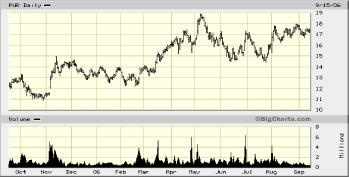
Revenue by Customer Type First 6 Months 2006
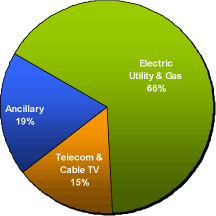
Historical Backlog Data* (In Billions) At End of Period
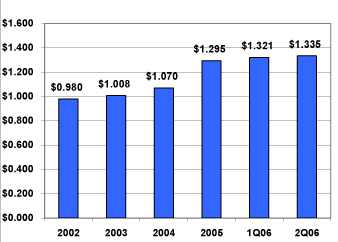
| * | Backlog represents the amount of revenue Quanta expects to realize from work to be performed over the next 12 months on uncompleted contracts, including new contractual agreements on which work has not yet begun. |
| Quanta Services, Inc. | ©2006 Quanta Services, Inc. All rights reserved. | Page 2 |
NYSE: PWR Forward-looking statements contained herein are subject to certain risks and uncertainties as further described on page 35 of this Company
Profile. Readers should carefully review the cautionary statement described in this and other documents filed from time to time with the SEC, including on Form 10-K.
Company Profile
|

|
September 2006 |
This document is being published by Quanta Services in continuation of the Companys goal to
provide more disclosure and transparency to the investment community regarding Quantas operations,
strategies, industry dynamics and conditions, etc.
Executive Summary & Selected Highlights
Quanta Services is a leading national provider of specialty contracting solutions to the electric
power, natural gas, telecommunications, broadband cable television and specialty services
industries. Quanta was created to respond to the increasing need for the outsourcing of
infrastructure services. That is, Quantas current and future customers are expecting, as they grow
their businesses through mergers and increased outsourcing, specialty contractors to increase the
scope of their service capabilities and geographic reach. Through its operating units located
across the United States, Quanta provides design, installation, repair, maintenance and emergency
response services that assist customers in reducing costs, increasing operating efficiencies and
improving network performance.
The August 2003 power blackout, the largest in North Americas history, brought to the forefront
what the power industry has known for years: the nations power grid is old, overloaded and in need
of significant upgrades and maintenance to serve the countrys current and future power needs.
Quanta estimates that it will cost between $100 billion and $200 billion over the next ten to
fifteen years to expand, upgrade and maintain the United States transmission and distribution
(T&D) system adequately. Prompted in part by the August 2003 blackout, the Energy Policy Act of
2005 (EPAct) was signed into law to, among other things, improve the nations electric transmission
capacity and reliability and to promote investment in the nations energy infrastructure.
Quanta and the industries it serves have emerged from one of the most difficult operating
environments in thirty years due to challenging economic and capital markets conditions and the
collapse of the telecommunications industry from 2001 through 2003. However, Quantas customers
have largely regained their financial strength and operational stability and their spending
patterns have been improving. It may take some additional time before customer spending levels and
Quantas margins return to normal levels, but both spending and margins have been trending upwards
and Quanta believes its operating environment is headed in a positive direction. As favorable
operating conditions and growth opportunities continue, there are several major trends that could
generate long-term organic revenue growth opportunities of approximately 10-15% annually:
| | Increased spending due to utilities implementing provisions in the EPAct |
| | Transmission and distribution network upgrade needs and new telecommunications network upgrade initiatives |
| | Increased opportunities due to fiber-to-the premise (FTTP) and/or fiber-to-the-node (FTTN) initiatives |
| | Higher capital expenditure levels resulting from Quantas customers improved financial condition |
| | Quantas customers increased focus on their core business |
| | Increased outsourcing of infrastructure services |
Quanta remains focused on its operations and on maintaining a healthy financial position. Quanta
has seen its end-markets experience increased stability and show signs of growth over the past
year. As Quantas customers financial health has improved, these customers have been increasing
investment in their infrastructure networks. Quanta is assuming industry trends will remain
positive and expects to continue to improve margins and profitability through the course of the
year. With $309.5 million of cash on its balance sheet as of June 30, 2006, Quanta believes it is
well positioned, both financially and operationally, to capitalize on future growth opportunities
in the industries it serves.
| Quanta Services, Inc. | ©2006 Quanta Services, Inc. All rights reserved. | Page 3 |
NYSE: PWR Forward-looking statements contained herein are subject to certain risks and uncertainties as further described on page 35 of this Company
Profile. Readers should carefully review the cautionary statement described in this and other documents filed from time to time with the SEC, including on Form 10-K.
Company Profile
|

|
September 2006 |
Table of Contents
(Noteworthy new or updated information in this edition versus the previous edition in bold)
| SECTION | PAGE | |||
Overview & Key Points |
1 | |||
Summary Financial Data |
2 | |||
Executive Summary & Selected Highlights |
3 | |||
Quanta Services Company Overview |
5 | |||
Major Market Trends & Outsourcing Thesis |
6 | |||
Energy Policy Act of 2005
|
6 | |||
Heightened Awareness of Network Upgrade Needs
|
6 | |||
Telecommunications Network Maintenance & Upgrade Needs
|
8 | |||
Customers Focusing on Core Business; Value of End-to-End Solutions
|
8 | |||
Increased Outsourcing of Infrastructure Services
|
8 | |||
Massive Need for Transmission & Distribution Upgrade & Maintenance |
10 | |||
Quanta Services Operations Overview |
14 | |||
Electric Utility Infrastructure Services
|
16 | |||
Energized Services
|
17 | |||
Energized Services Case Study
|
18 | |||
Natural Gas & Pipeline Services
|
19 | |||
Telecommunications Network Services
|
19 | |||
Broadband Cable Television Services
|
20 | |||
Specialty Services
|
20 | |||
Understanding Margins |
21 | |||
Quantas Growth Strategy Steady Organic Growth Supplemented by Selected Acquisitions |
22 | |||
Recent Financial Results & Commentary |
23 | |||
Historical Financial & Operating Data Table |
27 | |||
Peer Operation & Valuation Comparison |
28 | |||
Executive Management Bios |
29 | |||
Consolidated Statements of Operations |
31 | |||
Consolidated Balance Sheets |
32 | |||
Consolidated Statements of Cash Flows |
33 | |||
Forward-Looking Statements & Risk Factors |
34 | |||
| Note: This Company Profile contains information provided by Quanta Services, Inc. and by other sources Quanta believes are reliable. Quanta cannot assure investors that any information obtained from other sources is accurate or complete. | ||
| Quanta Services, Inc. | ©2006 Quanta Services, Inc. All rights reserved. | Page 4 |
NYSE: PWR Forward-looking statements contained herein are subject to certain risks and uncertainties as further described on page 35 of this Company
Profile. Readers should carefully review the cautionary statement described in this and other documents filed from time to time with the SEC, including on Form 10-K.
Company Profile
|

|
September 2006 |
Quanta Services Company Overview
Quanta Services is a leading national provider of specialty contracting solutions to the electric
power, natural gas, telecommunications, broadband cable television, and specialty services
industries. Through its operating units located throughout the United States, Quanta provides
design, installation, repair, maintenance and emergency response services that assist Quantas
customers in reducing costs, increasing operating efficiencies and improving network performance.
The Company also provides a variety of specialty services such as energized energy services; inside
electrical wiring; intelligent traffic networks; cable and control systems for light rail lines,
airports and highways; and specialty rock trenching, directional boring and road milling for
industrial and commercial customers.
Quanta was created to respond to the increasing need for outsourced infrastructure services.
Quantas customers are expecting specialty contractors to increase the scope of their service
capabilities and geographic reach as these customers grow their businesses through mergers and
increased outsourcing. These requirements are a tall order for the average private specialty
contractor, so in February 1998, Quanta became a publicly traded company to obtain additional
capital to pursue a strategy of smart growth consolidation coupled with organic growth. This
decision was driven by increased infrastructure services outsourcing trends and greater customer
demands.
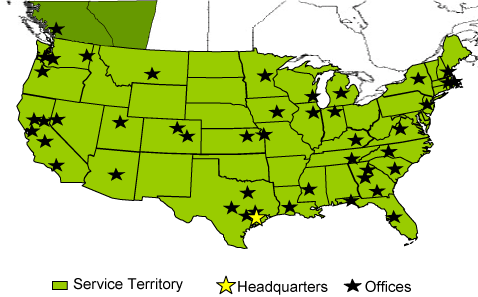
After its IPO, Quanta selectively acquired approximately 85 specialty contractors over several
years to increase the scope of its services, expand its geographic reach and diversity, and enhance
its future growth opportunities. Though initially focused on the electric utility industry, Quanta
expanded into the telecommunications and broadband cable television infrastructure services
industries as its core utility customers began expanding into those unregulated sectors and turned
to Quanta to provide simultaneous electrical, telecommunications and broadband cable television
infrastructure services.
Due to challenges in the telecommunications and broadband cable television sectors from 2001
through 2003, Quantas utility customers largely have ceased pursuing telecommunications and
broadband cable television initiatives and have refocused on the electric and gas utility side of
their businesses. Quanta believes that its customers operational refocusing and improved balance
sheets coupled with favorable regulatory developments in the utility, telecommunications and
broadband cable TV industries create a positive operating environment for Quanta.
| Quanta Services, Inc. | ©2006 Quanta Services, Inc. All rights reserved. | Page 5 |
NYSE: PWR Forward-looking statements contained herein are subject to certain risks and uncertainties as further described on page 35 of this Company
Profile. Readers should carefully review the cautionary statement described in this and other documents filed from time to time with the SEC, including on Form 10-K.
Company Profile
|

|
September 2006 |
Major Market Trends & Outsourcing Thesis
| | Energy Policy Act of 2005 |
| | Heightened Awareness of Network Upgrade Needs |
| | Customers Focused on Core Business; Value of End-to-End Solutions |
| | Increased Outsourcing of Infrastructure Services |
Energy Policy Act of 2005
Signed into law in August 2005, the EPAct includes provisions designed to improve the nations
electric transmission capacity and reliability and to promote investment in the nations energy
infrastructure. The EPAct calls for a self-regulated reliability organization that will implement
and enforce mandatory reliability standards on all market participants, with oversight by the
Federal Energy Regulatory Commission (FERC). FERC is required to issue rules promoting capital
investment to enlarge, improve and maintain the nations transmission facilities; provide a rate of
return that attracts investment in transmission; and provide for recovery of costs of complying
with the new mandatory reliability standards. As a result, over the next twelve to twenty-four
months, Quanta expects many utilities to evaluate the condition of their infrastructure more
closely and act on much needed upgrades to meet the higher reliability standards and ever
increasing demand.

FERC is also authorized to issue permits for the construction or modification of transmission
facilities within national interest electric transmission corridors when states fail to act in a
timely manner or lack authority to issue permits. Quanta expects these new rules to lead to a
streamlined permitting process, which should make investment in the nations transmission system
more attractive.
The EPAct also modifies a longstanding barrier to effective competition by repealing the Public
Utility Holding Company Act (PUHCA). The repeal of PUHCA is expected to attract new investors in
this sector. These non-utility investors are likely to focus on reducing costs, while enabling
utilities to focus on their core competencies. Quanta believes that the repeal of PUHCA may lead to
increased interest in outsourcing solutions.
Heightened Awareness of Network Upgrade Needs
Due to challenging operating and capital market conditions, the collapse of the telecommunications
industry from 2001 through 2003 and previous regulatory uncertainties, many service providers in
the industries Quanta serves have not adequately invested in their networks. This has been a
problem in the electric utility industry for many years, which was highlighted during the August
2003 power blackout. The collapse of the telecommunications industry from 2001 through 2003
resulted in nearly all telecommunications companies significantly reducing network maintenance and
minimizing expansion plans for several years. These issues have created demand for general network
maintenance as well as for new network development to handle demand and competition for new
communications and entertainment services.
| Quanta Services, Inc. | ©2006 Quanta Services, Inc. All rights reserved. | Page 6 |
NYSE: PWR Forward-looking statements contained herein are subject to certain risks and uncertainties as further described on page 35 of this Company
Profile. Readers should carefully review the cautionary statement described in this and other documents filed from time to time with the SEC, including on Form 10-K.
Company Profile
|

|
September 2006 |
Need for Transmission & Distribution (T&D) Network Upgrade & Maintenance Highlighted by Outages
For many years the electric power industry has not invested enough in its transmission and
distribution networks to keep pace with electricity demand. The August 14, 2003 power blackout
the largest power blackout in North Americas history highlighted the significant need for T&D
network upgrade and maintenance. Due to the number of people impacted by the catastrophic failure
of the United States. power grid, the event increased the nations awareness of what has been known
in the power industry for
many years: the nations electrical grid is old, overloaded and in need of significant maintenance
and expansion to handle the countrys current and growing power needs.
Despite previous power blackouts since the 1960s that left tens of millions of people in
the dark, expansion and maintenance of the grid has fallen short. As the countrys population has
grown and technology has become a larger part of everyday life, generating capacity has increased
nearly eight fold over the past ten years2 while demand for electricity has grown more
than 20%3. However, transmission capacity over the last ten years has fallen by
approximately 16% and is expected to decline by approximately 7% from 2003 to 20084.
While the August 2003 blackout was the worst in the nations history, it was not the first major
blackout impacting North America, and unfortunately, may not be the last. The accompanying table
lists examples of other major bulk electric system power outages that have hit North America. Note
that this list excludes many past power outage events that also impacted many people, such as the
rolling blackouts experienced in California during 2000 and 2001.
Each year there are smaller power outages that occur throughout North America. While these do not
get significant media attention, they are more frequent than one would expect. The chart to the
bottom right of the page depicts the number of power outages that occur versus the number of people
the outage impacts. For example, the orange data point in the lower right hand corner of the graph
represents the large outage of August 10, 1996, which affected more than seven million consumers in
eleven western states and two Canadian provinces.
| 2 | Cambridge Energy Research Associates | |
| 3 | Energy Information Administrations Early Release of the Annual Energy Outlook 2004. | |
| 4 | Expanding U.S. Transmission Capacity, Eric Hirst, Ph.D., August 2000. |
Examples of Major Bulk Electric System Power Outages
| States/Provinces | Customers | |||||
| Date | Affected | Affected | Duration | |||
11/9/1965
|
NY, CT, MA, RI, northern PA, northeast NJ, and Ontario, Canada | 30 million people; over 20,000 MW of demand | Up to 13 hours | |||
7/13/1977
|
New York City | 9 million people; 6,000 MW of demand | Up to 26 hours | |||
12/22/1982
|
West coast of US | +5 million people: over 12,350 MW of demand | NA | |||
7/2/1996
|
AZ, CA, CO, ID, MT, NB, NV, NM OR, SD, TX, UT, WA,& WY in the US; Alberta & British Columbia in Canada; Baja California Norte in Mexico | 2 million (10% of customers in the Western Interconnection); 11,850 MW of demand | From a few mins. to several hours | |||
8/10/1996
|
AZ, CA, CO, ID, MT, NB, NV, NM, OR, SD, TX, UT, WA, & WY in the US; Alberta & British Columbia in Canada; Baja California Norte in Mexico | 7.5 million people; 28,000 MW of demand shed by underfrequency load-shedding relays | Up to 9 hours | |||
6/25/1998
|
MN, MT, ND, SD, & WI in the US; Ontario, Manitoba & Saskatchewan in Canada | 152,000 customers; 950 MW of demand | 19 hours | |||
8/14/2003*
|
CT, MA, NY, VT, NJ, PA, OH, MI in the US; Ontario Provence in Canada | Approximately 50 million people 61,800 MW of electric load | Up to two days in some areas |
| Source: North American Electric Reliability Counsel & US-Canada Power System Outage Task Force | ||
| * Source: US-Canada Power System Outage Task Force: Causes of the August 14th Blackout | ||
U.S. Power System Outages, 1991 2000
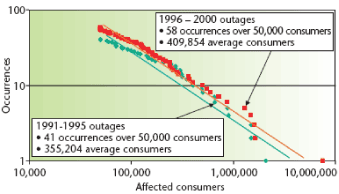
| Source: IEEE Security & Privacy, September/October 2003, North Americas | ||
| Electricity Infrastructure: Are We Ready for More Perfect Storms? | ||
| Quanta Services, Inc. | ©2006 Quanta Services, Inc. All rights reserved. | Page 7 |
NYSE: PWR Forward-looking statements contained herein are subject to certain risks and uncertainties as further described on page 35 of this Company
Profile. Readers should carefully review the cautionary statement described in this and other documents filed from time to time with the SEC, including on Form 10-K.
Company Profile
|

|
September 2006 |
Telecommunications Network Maintenance & Upgrade Needs
As a result of the challenges faced by telecommunications companies in the early part of this
decade, telecommunications networks have not been properly maintained over the last few years and
network expansion has been minimal.
Telecommunications industry spending stabilized in 2004, and in the latter half of 2004, several
significant new telecommunications initiatives were announced that require significant network
expansion and upgrades. These new initiatives involve bringing fiber optic cable much closer to the
end user: fiber to the home, fiber to the premise (FTTP) and fiber to the node (FTTN). Such
initiatives, often referred to as FTTx, are being implemented by Verizon and AT&T (formerly SBC
Communications), and municipalities have also become active in FTTx initiatives. These projects
will increase telecommunications network spending by billions of dollars over the next five to ten
years and should create favorable demand for the network installation and maintenance services
Quanta provides.
Quanta experienced increasing demand for its services in 2005 related to FTTx initiatives and
continues to see demand related to these initiatives year-to-date in 2006. Verizon confirmed that
it had passed more than three million homes and businesses in 16 states by the end of 2005. Verizon
also announced plans to pass an additional three million homes and businesses in 2006. In addition,
AT&T announced plans to deliver Internet telephone service to 18 million homes by the first half of
2008, including the installation of more than 38,000 miles of fiber at an estimated cost of $4
billion. This fiber will deliver integrated Internet Protocol (IP)-based television, high speed
Internet and voice and wireless bundles of products and services.
Customers Focusing on Core Business; Value of End-to-End Solutions
All of the industries Quanta serves are facing very competitive environments. After several years
of challenging economic and capital market conditions, many companies in the electric and gas
utility, telecommunications and broadband cable television industries have refocused their human
and financial assets on core operations, operating efficiencies and prudent capital investment in
their networks. The absolute dollar amount of network capital expenditures by Quantas customers
declined from 2002 through 2004. However, conditions stabilized in 2005 and since then Quantas
customers have begun to gradually increase spending on network maintenance and installation.
Network spending has not returned to historically normal levels, but customer indications,
bidding activity and other industry developments point to the return of a positive spending trend
by the industries Quanta serves.
One way for Quantas customers to focus on core operations, operating efficiencies and prudent
capital investment is to outsource non-revenue-generating functions, such as network infrastructure
development and maintenance. Small owner-operated contractors are not as well positioned as Quanta
to serve the broad range of needs that many utilities, telecommunications, and broadband cable
television companies request. Further, service providers are reducing the number of vendors they
deal with to reduce paperwork, bidding and vendor management costs, and time. Increasingly, the
industries Quanta serves are looking for companies like Quanta that are able to provide a wide
array of network infrastructure services on a national basis on time and on budget.
Increased Outsourcing of Infrastructure Services
Challenging economic and capital market conditions, stiff competition among peers, focus on
efficiencies, and the need to enhance and maintain the lifeblood of their business their networks
are causing companies in the electric and gas utility, telecommunications, and broadband cable
television industries to
| Quanta Services, Inc. | ©2006 Quanta Services, Inc. All rights reserved. | Page 8 |
NYSE: PWR Forward-looking statements contained herein are subject to certain risks and uncertainties as further described on page 35 of this Company
Profile. Readers should carefully review the cautionary statement described in this and other documents filed from time to time with the SEC, including on Form 10-K.
Company Profile
|

|
September 2006 |
increase the amount of network infrastructure work outsourced to specialty contractors like Quanta
Services.
Quanta estimates that annual outsourced infrastructure spending in the primary industries Quanta
serves is in excess of $30 billion. Quanta further estimates that the electric power and natural
gas industry typically outsources approximately 30%-40% of its infrastructure work to specialty
contractors, the telecommunications industry typically outsources approximately 50%-60% of its
infrastructure work, and the broadband cable television industry typically outsources approximately
70%-80% of its infrastructure work to specialty contractors. As economic, capital market and
operating conditions have generally improved for Quantas customers, they have begun to return to
more normalized levels of investment in their networks. As a result, Quantas annual addressable
market opportunity and the amount of work that is outsourced should grow.
In addition to service providers outsourcing elements of their network installation and maintenance
activities, Quanta believes there is significant opportunity in its customers completely
outsourcing the operation and maintenance of their network infrastructure (utilities,
telecommunications and broadband cable television companies alike). In fact, Quanta is the only
specialty contractor to successfully develop and implement a complete infrastructure outsourcing
program with an electric utility.
Puget Sound Energy was one of the first utilities to announce that it would progressively outsource
100% of its infrastructure operations and maintenance functions. Puget Sound Energy considered
twelve different companies for this vital task and chose Quanta for both electric and gas
infrastructure outsourcing initiatives. Today, Quanta is managing all electric and gas construction
for new residences and businesses in Puget Sounds Washington service area, as well as managing all
related inventory and materials. Under Quantas management, productive work hours have increased by
at least one hour per day, a 30% cost savings over historical numbers is projected, and service
levels continue to improve. Puget Sound Energy and Quanta forged new ground with this outsourcing.
As it has proven successful, more companies are seriously examining a complete outsourcing model.
| Quanta Services, Inc. | ©2006 Quanta Services, Inc. All rights reserved. | Page 9 |
NYSE: PWR Forward-looking statements contained herein are subject to certain risks and uncertainties as further described on page 35 of this Company
Profile. Readers should carefully review the cautionary statement described in this and other documents filed from time to time with the SEC, including on Form 10-K.
Company Profile
|

|
September 2006 |
Massive Need for Transmission & Distribution Upgrades & Maintenance
The August 2003 power blackout, the largest in North Americas history, brought to the forefront
what the power industry has known for years: the nations power grid is old, overloaded, and needs
significant upgrades and maintenance to serve the countrys current and future power needs. With a
concerned public and 50 million angry northeastern constituents, politicians began taking the
grids most spectacular failure seriously, as is evident with the passage of EPAct.
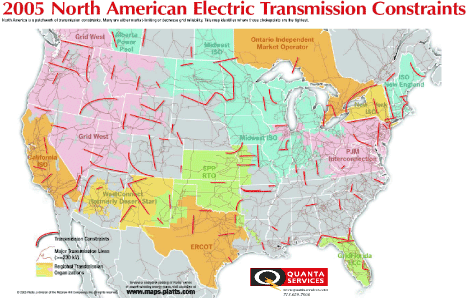
| Source: Platts Research | ||
The challenge the industry faces is not one of a shortage of electricity and generating
capacity, but capacity constraints and bottlenecks for transmitting and distributing the
electricity to the end user. The map above depicts the nations major transmission lines and
identifies key capacity constraints. As indicated, there are a troubling number of key transmission
capacity constraints. As indicated by the charts below, while demand for electricity has grown over
20% over the past decade, transmission capacity has fallen by approximately 16% and is expected to
decline further by approximately 7% from 2003 to 2008. It is believed the EPAct will help to reduce
transmission constraints and reliability.
Normalized Transmission Capacity
(MW Miles/MW Demand)
(MW Miles/MW Demand)
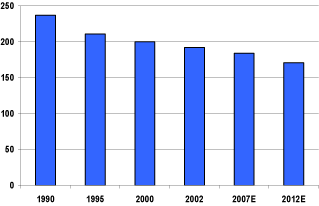
| Source: Edison Electric Institute: U.S. Transmission Capacity: Present Status & Future Prospects | ||
| Quanta Services, Inc. | ©2006 Quanta Services, Inc. All rights reserved. | Page 10 |
NYSE: PWR Forward-looking statements contained herein are subject to certain risks and uncertainties as further described on page 35 of this Company
Profile. Readers should carefully review the cautionary statement described in this and other documents filed from time to time with the SEC, including on Form 10-K.
Company Profile
|

|
September 2006 |
Net Electricity Generation to Grid
vs. Electricity Consumption
vs. Electricity Consumption
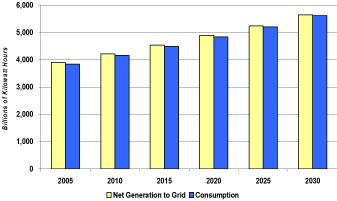
| Source: Energy Information Administration: Annual Energy Outlook 2006 | ||
Quanta estimates that it will cost between $100 billion and $200 billion to significantly
upgrade and maintain the United States transmission and distribution (T&D) system over the next ten
to fifteen years. The Edison Electric Institute estimates that more than $6 billion will be
invested in transmission by integrated and stand-alone transmission companies in 2006. According to
Platts Research, currently there are more than 700 proposed transmission projects totaling over
23,700 miles being planned.
According to Platts, before the August 2003 blackout there was $27.5 billion worth of T&D projects
beginning in 2004 with completion by 2008. The discrepancy between the amount of earmarked projects
before the blackout versus the significant amount that is estimated as necessary to meaningfully
upgrade the nations T&D infrastructure illustrates the magnitude of the electric power industrys
underinvestment in its T&D infrastructure over the years. Prior to the August 2003 blackout, R.J.
Rudden Associates estimated that bringing spending in line with forecast demand would require a 25%
annual increase in transmission spending and a 50% annual increase in distribution spending (see
data on following page).
The majority of the nations T&D infrastructure was built shortly after World War II, is over 50
years old in many cases, and is beyond its useful life. The table below illustrates the number of
poles installed annually by a particular electric power utility. While the identity of the specific
utility is concealed, the chart illustrates an investment pattern that is typical for the average
United States electric utility. The vast majority of the grid system was installed from 1945 to the
late 1970s. With these assets already past or rapidly approaching the end of their useful life, as
depicted in the chart below, significant demand now exists for pole repair and replacement going
forward based on past T&D investment.
# of Poles Installed By Year Representative of the Typical Electric Utility
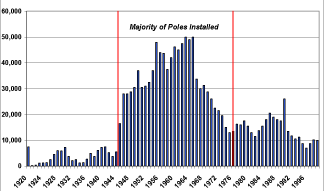
Implied Demand for Pole Replacement & Repair for the Typical Electric Utility
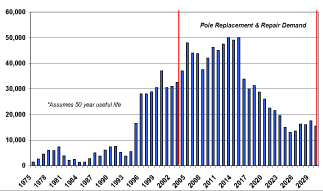
Electric utilities have underinvested in their T&D infrastructure for three primary reasons: (1)
uncertainty regarding the final terms of the Federal Energy Regulatory Commissions (FERC) standard
market design proposal, (2) the inability to recover investment costs in T&D investment under state
imposed rate freezes, and (3) lack of capital to invest as a result of energy trading losses,
telecommunications business investments and other financial pressures.
With the enactment of the EPAct in 2005, many regulatory uncertainties have been cleared up and
utilities have begun to analyze their T&D infrastructure in light of new reliability requirements
as well as new regulations that make investment in their networks more attractive and easier to
complete. In fact, a number of aspects of the EPAct have already been implemented and utilities are
responding accordingly. Further, improved economic conditions and stronger utilities balance
sheets have better positioned utilities to invest in their T&D networks.
| Quanta Services, Inc. | ©2006 Quanta Services, Inc. All rights reserved. | Page 11 |
NYSE: PWR Forward-looking statements contained herein are subject to certain risks and uncertainties as further described on page 35 of this Company
Profile. Readers should carefully review the cautionary statement described in this and other documents filed from time to time with the SEC, including on Form 10-K.
Company Profile
|

|
September 2006 |
It is troubling that investment in T&D infrastructure has declined over the years while
demand for electricity has meaningfully increased. Coupled with the fact that much of the nations
T&D infrastructure is 50 years old, it is apparent that the power industry is increasingly relying
on aging assets. This is a recipe for significant future problems as power demand increases on an
aged and overloaded grid.
Deflated T&D Expenditures in Year 2000 Dollars
($ in Billions)
| 1985-1989 | 1990-1994 | 1995-1999 | 2000-2004 | |||||||||||||
Transmission |
||||||||||||||||
Spending in Period |
$ | 14.5 | $ | 16.2 | $ | 13.2 | $ | 16.2 | ||||||||
Replacement Spending Required |
12.2 | 19.1 | 21.9 | 21.4 | ||||||||||||
Net New Spending (Deficiency) |
$ | 2.3 | ($2.9 | ) | ($8.7 | ) | ($5.2 | ) | ||||||||
Distribution |
||||||||||||||||
Spending in Period |
$ | 53.8 | $ | 56.6 | $ | 49.1 | $ | 33.5 | ||||||||
Replacement Spending Required |
37.0 | 45.6 | 49.1 | 46.8 | ||||||||||||
Net New Spending (Deficiency) |
$ | 16.8 | $ | 11.0 | $ | 0.0 | ($13.3 | ) | ||||||||
The table to the right depicts adjusted historical utility T&D expenditures and suggests that (1)
capital spending has not been sufficient to replace old transmission assets and (2) sufficient
spending has not been earmarked to replace aging distribution assets in the future. As the graphs
and data show, utility investment in the expansion and maintenance of T&D assets has lagged behind what is needed.
Transmission System
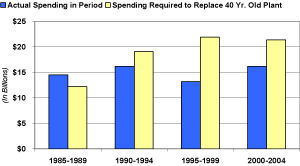
Expanding and improving current T&D assets to meet current and future power demand is a
daunting task. Further complicating the issue, the demand for electricity is expected to continue
to grow at a healthy rate for the next few decades as (1) the countrys population expands and (2)
we become increasingly dependent on technology, which requires power. The good news is utilities
have increased spending on transmission lines after a period of declining spending. Based on data
depicted below, it is anticipated that utilities will meaningfully increase annual transmission
spending through 2008 and beyond.
Distribution System
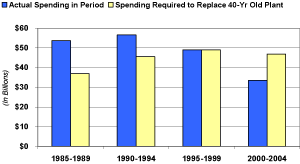
| Engineering News Record Construction Index used as deflator. | ||
| Source: R.J. Rudden Associates, Inc. | ||
| Quanta Services, Inc. | ©2006 Quanta Services, Inc. All rights reserved. | Page 12 |
NYSE: PWR Forward-looking statements contained herein are subject to certain risks and uncertainties as further described on page 35 of this Company
Profile. Readers should carefully review the cautionary statement described in this and other documents filed from time to time with the SEC, including on Form 10-K.
Company Profile
|

|
September 2006 |
% of Electricity Revenue Reinvested in Construction
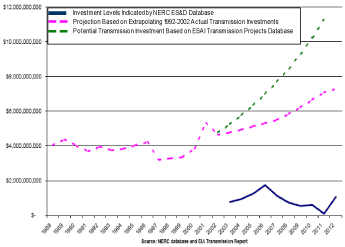
| Source: Edison Electric Institute: Meeting U.S. Transmission Needs | ||
Actual & Planned Transmission Investment by
Integrated & Stand Alone Transmission Companies
Integrated & Stand Alone Transmission Companies
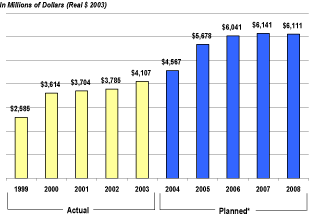
The Handy-Whitman Index of Public Utility
Construction Costs used to adjust for inflation from
year-to-year. Data represents shareholder-owned electric
utilities. * Planned total industry expenditures
estimated from 95% response rate to EEIs Electric
Transmission Capital Budget & Forecast Survey as of
5/05. Actual expenditures from EEIs Annual Property &
Plant Capital Investment Survey and FERC Form 1s.
The map below illustrates the estimated demand for electricity by state in the United States
from 2003 to 2014. Platts estimates that overall electricity demand in the United States will grow
in excess of 20% over this period. Areas such as California and the northeastern United States are
expected to have 40%-55% increases in electricity demand over the period. Both of these areas have
had major blackouts and brownouts in the past few years.
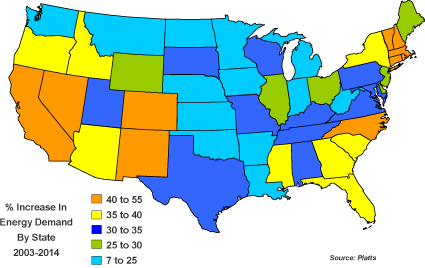
The electric utility industry finds itself in the position of playing catch-up from
underinvestment, needing to replace and repair a significant amount of its legacy distribution
network, and properly plan for future electricity demand. The August 2003 blackout caught the
attention of utilities and politicians, and was a catalyst for the adoption of the EPAct in August
2005. Quanta expects the EPAct to lead to increased infrastructure investment by utilities over the
next twelve to twenty-four months. As one of the largest specialty electrical infrastructure
contractor in the country, Quanta is well positioned to meet the needs of its customers and to
benefit from future increases in T&D network investment by the electric utility industry.
| Quanta Services, Inc. | ©2006 Quanta Services, Inc. All rights reserved. | Page 13 |
NYSE: PWR Forward-looking statements contained herein are subject to certain risks and uncertainties as further described on page 35 of this Company
Profile. Readers should carefully review the cautionary statement described in this and other documents filed from time to time with the SEC, including on Form 10-K.
Company Profile
|

|
September 2006 |
Quanta Services Operations Overview
For the three months ending June 30, 2006, revenues generated by customers in the electric power
and natural gas industries accounted for approximately 66% of revenue, telecommunications and
broadband cable television for approximately 17% and ancillary for approximately 17%. For the year
2005, revenues generated by customers in the electric power and natural gas industries accounted
for approximately 67% of revenue, telecommunications and broadband cable television for
approximately 15% and ancillary for approximately 18%. For the year 2004, revenues generated by
customers in the electric power and natural gas industries accounted for approximately 65% of
revenue, telecommunications and broadband cable television for approximately 17% and ancillary for
approximately 18%.
Quanta estimates that annual infrastructure spending in the primary industries Quanta serves is in
excess of $30 billion. Of that, Quanta estimates that the six largest public and private specialty
contractors serving these combined industries only account for 15% or less of the market. Quanta
estimates that it commands the largest portion of this estimated 15% share, but it is less than 5%
of the total addressable market. The balance of the market is served by smaller, typically private
companies. With its broader scope of services, greater financial and organizational resources, and
superior work force, Quanta believes it has significant opportunities to increase its market share
over time. Quanta estimates that currently approximately 30%-40% of electric and gas infrastructure
work is outsourced, 50%-60% of telecommunications infrastructure work is outsourced, and 70%-80% of
broadband cable television infrastructure work is outsourced.
As the accompanying charts depict, the percentage of revenues Quanta derived from the
telecommunications and broadband cable television industries for the first six months of 2006 was
significantly less versus the year 2001. This is primarily due to the historic collapse of the
telecommunications market and a challenging operating environment in the broadband cable television
market from 2001 through 2003. During that period, nearly all of Quantas telecommunications and
broadband cable television customers experienced operating and financial challenges, and a number
of Quantas telecommunications and broadband cable television customers filed for bankruptcy. As a
result, capital expenditures and overall network investment by the telecommunications and broadband
cable television sectors during that period declined significantly versus levels in the late 1990s
and early 2000, and also relative to normal historical levels. Expenditures in the
telecommunications and broadband cable TV sector have stabilized and are beginning to increase.
Revenue by Customer Type Year 2001
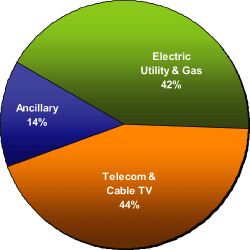
Revenue by Customer Type Six Mos. 2006

| Quanta Services, Inc. | ©2006 Quanta Services, Inc. All rights reserved. | Page 14 |
NYSE: PWR Forward-looking statements contained herein are subject to certain risks and uncertainties as further described on page 35 of this Company
Profile. Readers should carefully review the cautionary statement described in this and other documents filed from time to time with the SEC, including on Form 10-K.
| Company Profile |

|
September 2006 |
Quanta believes the effects of the historic downturn of the telecommunications industry from
2001 through 2003 have passed, and the industry has stabilized and is selectively pursuing growth
opportunities. There are several telecommunications initiatives currently in discussion and
underway by several government organizations, wire line carriers and wireless carriers that are
providing Quanta with growth opportunities, in particular FTTx initiatives. Quanta believes these
initiatives will continue through 2006. However, Quanta currently does not believe these
opportunities are indicative of an overall return to historical network investment levels by the
telecommunications industry as a whole.
As the industries Quanta serves continue to gain strength and gradually increase network spending,
the Company has begun to see gross margins improve. In fact, Quanta has been experiencing improved
margins on new work and believes that margins could continue to improve through the balance of the
year.
Quanta is unique from its competitors because it has a diversified network infrastructure service
offering for its customers and a diversified customer base. For the second quarter of 2006,
Quantas largest customer accounted for approximately 6% of revenues. For the second quarter of
2006, Quantas top ten and top twenty customers accounted for approximately 34% and 50% of
revenues, respectively. This diverse customer base reduces Quantas reliance on any one customer in
a given period and is one reason why the Company was able to remain financially healthy through the
tumultuous telecommunications downturn over the past few years.
Quanta has low customer concentration...
| For Most Recent Fiscal Quarter | ||||||||||||||||
| Largest | Top 5 | Top 10 | Top 20 | |||||||||||||
| Customer | Customers | Customers | Customers | |||||||||||||
Dycom Industries |
23 | % | 61 | % | +70 | % | +70 | % | ||||||||
MasTec |
34 | % | 62 | % | 76 | % | +76 | % | ||||||||
InfraSource |
18 | % | NR | 54 | % | NR | ||||||||||
Quanta Services |
6 | % | 23 | % | 34 | % | 50 | % | ||||||||
Source: Form 10-Qs filed with the SEC and company documents
... and a high quality, diversified customer base
Quantas Top 20 Customers for the Quarter Ending 6/30/06
| 1 | Puget Sound Energy | |
| 2 | Southern California Edison | |
| 3 | Verizon | |
| 4 | Lower Colorado River Auth. | |
| 5 | CenterPoint Energy | |
| 6 | San Diego Gas & Electric | |
| 7 | American Electric Power | |
| 8 | AT&T | |
| 9 | BellSouth | |
| 10 | Pacific Gas & Electric | |
| 11 | Xcel Energy | |
| 12 | Intermountain Rural Electric | |
| 13 | Ericsson | |
| 14 | United Power | |
| 15 | Crosstex Energy Services | |
| 16 | Alabama Power | |
| 17 | Kenny Construction | |
| 18 | Florida Power & Light | |
| 19 | Georgia Power | |
| 20 | Alltel |
Quantas backlog at the end of the second quarter of 2006 was approximately $1.335 billion, which
is the amount of revenue it expects to realize from work to be performed over the next twelve
months on uncompleted contracts, including new contractual agreements on which work has not begun.
Quantas backlog at the end of the second quarter of 2006 of $1.335 billion was up from backlog at
the end of the second quarter of 2005 of $1.200 billion, and up versus backlog of $1.295 billion at
the end of 2005. Approximately one third of Quantas revenues are typically derived from strategic
alliances the Company has with various customers, engineering firms, manufacturers, distributors,
and others.
| Quanta Services, Inc. | ©2006 Quanta Services, Inc. All rights reserved. | Page 15 |
NYSE: PWR Forward-looking statements contained herein are subject to certain risks and uncertainties as further described on page 35 of this Company
Profile. Readers should carefully review the cautionary statement described in this and other documents filed from time to time with the SEC, including on Form 10-K.
| Company Profile |

|
September 2006 |
Historical Backlog Data* (In Billions) At End of Period
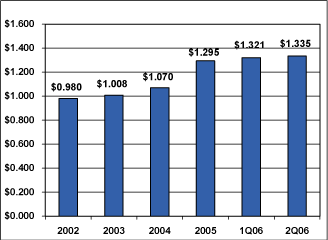
| * | Backlog represents the amount of revenue Quanta expects to realize from work to be performed over the next 12 months on uncompleted contracts, including new contractual agreements on which work has not yet begun. |
It is important to understand that Quantas business is typically influenced by seasonal factors.
These factors include influences due to weather, capital expenditure spending patterns, bidding
seasons, and holidays. Typically, Quantas revenues are lowest in the first quarter of the year
because cold, snowy or wet conditions cause delays. The second quarter is typically better than the
first, as some projects begin, but continued cold and wet weather can often impact second quarter
productivity. The third quarter is typically the best of the year, as a greater number of projects
are underway and weather is more accommodating to work on projects. Revenues during the fourth
quarter of the year are typically lower than the third quarter but higher than the second quarter.
Many projects are completed in the fourth quarter and revenues often are positively impacted by
customers seeking to spend their capital budget before the end of the year; however, the holiday
season and inclement weather sometimes can cause delays.
Electric Utility Infrastructure Services
Quanta performs a complete range of specialty contracting installation, maintenance and repair
services for the electric utility industry. Types of electric utility customers include
investor-owned utilities (IOUs), independent power producers (IPPs), rural electric associations
(REAs) and federal, state and municipal agencies.
As the largest specialty electric power contractor in the United States, Quanta has some of the
most experienced contractors and employees in the industry. In fact, a number of the companies that
are now part of Quanta contributed to the original build-out of the national transmission and
distribution system over 70 years ago.
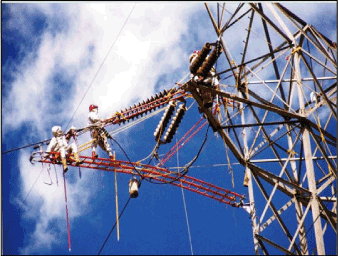
Quanta has the ability to handle any electrical infrastructure need for its customers. From
project-based engineering and construction of a multi-state, several hundred mile, high voltage
transmission line and substation system to complex underground distribution networks, Quanta can
handle every size and scope of power project. In fact, there are more than 200,000 miles of
overhead electrical lines and thousands of miles of underground electrical cable that have been
built and/or are maintained by Quanta Services.
Some of Quantas power infrastructure services capabilities include:
| | Design-build or engineer-procure-construct (EPC) services | ||
| | Construction and maintenance of transmission lines from 69kV to 765 kV | ||
| | Installation and maintenance of all kinds of distribution facilities | ||
| | Substation engineering and construction | ||
| | Energized installation, maintenance and upgrades utilizing proprietary robotic arm, barehand and hotstick methods | ||
| | Emergency power restoration | ||
| | Power and control cable pulling, splicing, terminating and testing | ||
| | Joint electric, gas and telecommunications installations, and much more |
| Quanta Services, Inc. | ©2006 Quanta Services, Inc. All rights reserved. | Page 16 |
NYSE: PWR Forward-looking statements contained herein are subject to certain risks and uncertainties as further described on page 35 of this Company
Profile. Readers should carefully review the cautionary statement described in this and other documents filed from time to time with the SEC, including on Form 10-K.
| Company Profile |

|
September 2006 |
Energized Services
One of Quantas significant competitive advantages on the power side is its unmatched expertise and
capabilities in the field of energized services. Quantas energized services and techniques enable
Quanta to perform a wide variety of installation, maintenance, rebuild and repair services to
almost all parts of an electric network while the network remains energized, without service
interruption. Unique to Quantas specialty electrical service offering is its exclusive, patented
LineMasterTM Robotic Arm. Quanta owns the United States rights and the exclusive right
to use the LineMaster Robotic Arm for more than the next 10 years. The LineMaster Robotic Arm is
used in the construction, maintenance, repair, and improvement of energized T&D lines and
substation facilities, and can reduce project completion times by more than 50% versus traditional
methods. The telescoping robotic arm temporarily supports live power lines to allow repair or
replacement of transmission poles, cross-arms, insulators, etc., while maintaining an energized
connection. Importantly, this capability prevents Quantas customers from having to shut down a
portion of the power grid to allow work to be done, eliminating downtime costs and angry consumers.
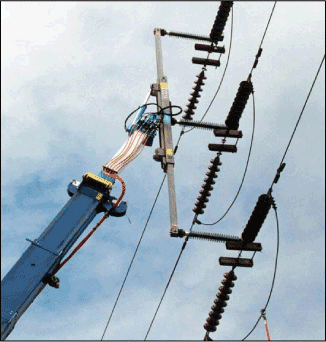
Hotstick & Barehand Hotstick and barehand techniques also enable crews to work on lines without
interrupting the customers power supply. Quanta uses hotsticks to move conductors, install fuses,
and open and close switches. For more intricate repairs, Quantas crews use barehand techniques in
which live-line workers wear specially designed protective gear that enables them to work at the
same electrical potential as the line. Quantas employees performing energized services are
hand-selected, experienced journeymen, each of whom have completed more than 120 hours of
specialized barehand training and annual, recurrent training to be energized certified.
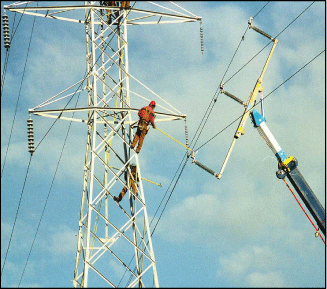
Barehand crews can safely handle and efficiently repair live lines up to 765kV. On one project,
Quanta used barehand techniques to repair a nuclear plants 345kV substation switches in one day
without shutting down the reactor. This saved the utility an estimated $10 million the cost
associated with shutting down the reactor, making repairs, returning it to operation and making
spot market power purchases during the down time.
Coupling the LineMaster Robotic Arm technology with Quantas barehand and hotstick methods provides
a complete energized solution that increases efficiency, reliability, levelization, and safety.
| Quanta Services, Inc. | ©2006 Quanta Services, Inc. All rights reserved. | Page 17 |
NYSE: PWR Forward-looking statements contained herein are subject to certain risks and uncertainties as further described on page 35 of this Company
Profile. Readers should carefully review the cautionary statement described in this and other documents filed from time to time with the SEC, including on Form 10-K.
| Company Profile |

|
September 2006 |
Energized Services Case Study
Kansas City Power & Light (KCP&L) was experiencing transmission congestion on its LaCygne-Stilwell
Line, representing a major bottleneck for members and customers of the Southwest Power Pool (SPP)
who rely on the line for service. Since the line was vital to the service needs of KCP&L and the
SPP, taking the line out of service for any extended period of time for upgrades would have proved
extremely disruptive in the form of lost revenue, power outages, and angry customers.
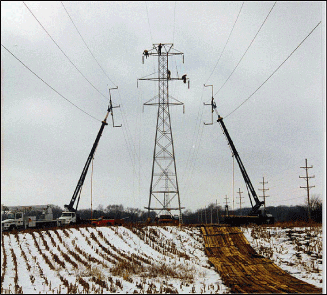
Since the line was built in 1972, KCP&L had done a number of system augmentations including
substation enhancements at either end of the line as well as installing monitoring equipment that
provided incremental capacity as power demand grew over the years. However, as KCP&L looked for
additional capacity enhancements for the line, it became clear that KCP&L would have to rebuild or
upgrade the line to truly solve its capacity problem.
The advent of a high-temperature conductor, or ACSS (aluminum conductor steel supported), meant
that the ACSS could carry twice the load of the conductors KCP&L was using on the line, and that if
the 345-kV line could be reconductored with the ACSS, KCP&L could use the existing H-frames
supporting the line. If this were able to be done while the line remained energized, the lines
capacity problem would be solved and customers would not experience any service disruption.
Because of Quantas unmatched expertise in energized services, proprietary tools and work methods,
KCP&L approached Quanta to work toward a rebuild solution on the LaCygne-Stillwell Line. Quanta
worked with KCP&L and developed a plan predicated on reconductoring the line while energized. At
that time, Quanta had worked on many energized projects for KCP&L, but none of this magnitude.
To do the job, Quanta used the Equal Potential Stringing Method, which isolated the working area
and the conductor being pulled, used proprietary processes, tools and equipment to solve
complicated issues and completed the project all while the line remained in service. The project
ran smoothly and was completed a month ahead of schedule, a major accomplishment given the snow and
mud experienced at the start of the project in February and spring rains and storms in May.
In summary, Quanta and KCP&L broke new ground with this project in solving transmission congestion
problems and upgrading conductors in an energized state. The project was completed ahead of
schedule in under five months and cost less than $8 million. Had the line been replaced using
traditional installation methods, the project would have taken longer, required the line to be shut
down for periods at a time, been significantly more costly, and been disruptive to customers.
| Quanta Services, Inc. | ©2006 Quanta Services, Inc. All rights reserved. | Page 18 |
NYSE: PWR Forward-looking statements contained herein are subject to certain risks and uncertainties as further described on page 35 of this Company
Profile. Readers should carefully review the cautionary statement described in this and other documents filed from time to time with the SEC, including on Form 10-K.
| Company Profile |

|
September 2006 |
Natural Gas & Pipeline Services
Like the electric power industry, the continued growth of the natural gas industry is expected to
generate significant activity, including the development of new pipelines and expansion or upgrades
of current systems. Natural gas consumption in the United States is expected to rise significantly
over the next two decades. Industry sources estimate that the United States needs 263,000 miles of
distribution pipelines and another 38,000 miles of large diameter transmission pipelines. With the
implementation of new legislative mandates requiring more structured and regular maintenance and
monitoring of systems, there has been a sharp increase in demand for gas and pipeline services.
Quantas services include the assessment, development, maintenance, and expansion of natural gas
pipelines. Quanta delivers a comprehensive set of solutions for the natural gas and pipeline
industries, including surveying, designing, installing, maintaining, and repairing and testing for
all systems and methods of transmitting natural gas. This includes transmission and distribution
pipelines, gathering systems, compressor stations, and meter stations.
Quanta also provides services for:
| | Corrosion protection and rehabilitation | ||
| | Permit and right-of-way acquisition | ||
| | Directional drilling | ||
| | Computer aided drafting | ||
| | Material specifications and acquisition |
Telecommunications Network Services
Quanta is equipped to provide a complete scope of services to the telecommunications industry for
both wire line and wireless services and is well positioned to capitalize on the demand for
services related to FTTx initiatives. Quantas telecommunications customers include incumbent local
exchange carriers (ILECs), long-distance carriers, rural telecommunications providers, competitive
local exchange carriers (CLECs), wireless carriers, and others. Quanta not only configures
telecommunications networks, but also provides the services to design, install, operate, test and
maintain them. Quanta has the capabilities to install and maintain fiber optic networks across the
country, through mountains, valleys and prairies, to businesses, buildings and homes, telephones
and modems. From route selection to positioning of the product, Quantas telecommunications network
services group provides a turnkey solution.

| Ø | Outside Plant Services Both overhead and underground: |
| | Plant design, engineering and construction drawings | ||
| | Right-of-way acquisition and permitting | ||
| | Overhead and underground installation, maintenance and repair of fiber optic and copper cable | ||
| | Cable splicing and testing |
| Ø | Inside Plant Services Starting with plant design, construction drawings and permitting, Quantas inside plant services encompass all elements of network integration. From riser installation to horizontal cabling, pathway construction and ongoing maintenance, including installation, cable splicing and materials procurement. Quantas inside plant services can serve single or multiple site needs. |
| Quanta Services, Inc. | ©2006 Quanta Services, Inc. All rights reserved. | Page 19 |
NYSE: PWR Forward-looking statements contained herein are subject to certain risks and uncertainties as further described on page 35 of this Company
Profile. Readers should carefully review the cautionary statement described in this and other documents filed from time to time with the SEC, including on Form 10-K.
| Company Profile |

|
September 2006 |
| Ø | Central Office Quantas central office services cover complete engineering, furnish and install (EF&I) needs nationwide. Quanta installs equipment designed by the industrys leading manufacturers. In fact, Quanta is certified to install the vast majority of the equipment telecommunications customers require. | |
| Ø | Wireless From monopole erection to orientation and sweep testing, Quanta provides wireless clients with design, build, and maintenance services as well as data transmission, project management and permitting processes associated with construction. Quanta crews construct cellular, digital, PCS, microwave and other wireless telecommunications towers and mobile switching offices. |
Broadband Cable Television Services
Quanta designs, installs, maintains and repairs entire residential and commercial broadband cable
television networks using both analog and digital technology. Quantas experience in the latest
broadband, telephony and data technologies, coupled with its inside and outside plant capabilities,
enable Quanta to seamlessly handle all phases of a networks lifespan from design and
installation to upgrade and maintenance projects. Likewise, Quantas ability to design and install
all types of broadband cable industry systems coaxial, fiber optic and hybrid systems provides
customers with a reliable resource for all potential needs. Quantas scope of services supports
advanced technologies including frame relay, SONET, Dense Wave Division Multiplexing (DWDM), and
MPEG. From DSL, ADSL and HDSL to video-on-demand, voice-over-IP or a full headend facility, Quanta
can do it all.
Quantas broadband cable network services include:
| | System and plant engineering | ||
| | Equipment installation, activation and testing | ||
| | Inside wiring, splicing and testing | ||
| | Permit and utility coordination | ||
| | Site preparation including rock trenching, directional drilling and mass excavation | ||
| | Rack installation, overhead and floor cable and fiber trays, and much more |
Specialty Services
In addition to the comprehensive services previously described, Quanta provides a number of
specialty services, many of which have applications and customers that span the electric and gas
utility, telecommunications, and broadband cable television industries. Quantas specialty services
capabilities include:
| | Pipeline transfer and bulk storage facilities | ||
| | Intelligent traffic networks including signals, controllers, message signs, and closed circuit monitoring | ||
| | Light rail tower installation, specialty wiring and ground wires | ||
| | Piping, tankage and control for airport fueling systems | ||
| | Wind generation facilities | ||
| | Rock trenching, directional drilling and road milling | ||
| | Vegetation control and tree trimming |
| Quanta Services, Inc. | ©2006 Quanta Services, Inc. All rights reserved. | Page 20 |
NYSE: PWR Forward-looking statements contained herein are subject to certain risks and uncertainties as further described on page 35 of this Company
Profile. Readers should carefully review the cautionary statement described in this and other documents filed from time to time with the SEC, including on Form 10-K.
| Company Profile |

|
September 2006 |
Understanding Gross Margins
It is important to understand how various factors some controllable, some not impact
Quantas gross margins on a quarterly or annual basis. Quantas gross margin is gross profit
expressed as a percentage of revenues. Cost of services consist primarily of salaries, wages and
benefits to employees, depreciation, fuel and other equipment expenses, equipment rentals,
subcontracted services, insurance, facilities expenses, materials and parts and supplies.
Seasonal and Geographical. Seasonal patterns can have a significant impact on gross margins.
Generally, business is slower in the winter months versus the warmer months of the year. This can
be offset somewhat by increased demand for electrical service and repair work resulting from severe
weather. In addition, the mix of business conducted in different parts of the country will affect
margins, as some parts of the country offer the opportunity for higher gross margins than others.
Weather. Adverse or favorable weather conditions can impact gross margins in a given period. For
example, it is typical in the first quarter of any fiscal year that parts of the country may
experience snow or rainfall that may negatively impact Quantas revenue and gross margin. In many
cases, projects may be delayed or temporarily placed on hold due to inclement weather. Conversely,
in periods when weather remains dry and temperatures are accommodating, more work can be done,
sometimes with less cost, which would have a favorable impact on gross margins. In some cases,
strong storms or hurricanes can provide Quanta with high margin emergency service restoration work,
which generally has a positive impact on margins.
Revenue Mix. The mix of revenue derived from the industries Quanta serves will impact gross
margins. Changes in Quantas customers spending patterns in each of the industries it serves can
cause an imbalance in supply and demand and, therefore, affect margins and mix of revenue by
industry served.
Service and Maintenance versus Installation. In general, installation work has a higher gross
margin than maintenance work. This is because installation work is often obtained on a fixed price
basis which has higher risk than other types of pricing arrangements. Quanta typically derives
approximately 50% of its revenue from maintenance work, which is performed under pre-established or
negotiated prices or cost-plus pricing arrangements. Thus, a higher portion of installation work in
a given quarter may result in a higher gross margin.
Subcontract Work. Work that is subcontracted to other service providers generally has lower gross
margins. An increase in subcontract work in a given period may contribute to a decrease in gross
margin. Quanta typically subcontracts approximately 10% 15% of its work to other service
providers.
Materials versus Labor. Margins may be lower on projects on which Quanta furnishes materials as
material prices are generally more predictable than labor costs. Consequently, Quanta generally is
not able to mark up materials as much as labor costs. In a given period, a higher percentage of
work that has a higher materials component may decrease overall gross margin.
Depreciation. Quanta includes depreciation in cost of services. This is common practice in Quantas
industry, but can make comparability to other companies difficult. This must be taken into
consideration when comparing Quanta to other companies.
Insurance. Gross margins could be impacted by fluctuations in insurance accruals related to
Quantas deductibles in the period in which such adjustments are made. As of June 30, 2006, Quanta
had a deductible of $1.0 million per occurrence related to employers and general liability
insurance and a deductible of $2.0 million per occurrence for automobile liability and
workers compensation insurance. Quanta also has a non-union employee health care benefit plan that
is subject to a deductible of $250,000 per claimant per year.
Again, it is important to understand how various factors impact gross margin. Just because gross
margin narrows in a quarter may not mean that Quanta is not managing its cost of services
well.
| Quanta Services, Inc. | ©2006 Quanta Services, Inc. All rights reserved. | Page 21 |
NYSE: PWR Forward-looking statements contained herein are subject to certain risks and uncertainties as further described on page 35 of this Company
Profile. Readers should carefully review the cautionary statement described in this and other documents filed from time to time with the SEC, including on Form 10-K.
| Company Profile |

|
September 2006 |
Quantas Growth Strategy Steady Organic Growth Supplemented by Selected Acquisitions
Quanta is optimistic that demand for its services will continue to grow through the remainder
of 2006 after recovering from several years of the most challenging and abnormal operating
environments for Quanta and its peers in thirty years. No one could have predicted the severity and
depth of the telecommunications industrys collapse and challenging environment for broadband cable
television, leading to the significant reduction in network development and maintenance investment.
The electric power industry, to a lesser extent, was impacted as well.
Throughout this period, Quanta transitioned from a company focused on growth to a company focused
on managing its business in a tumultuous environment. Quanta has been successful in reducing its
cost structure, streamlining operations, and improving its balance sheet. Quantas current
operating environment is much improved from several years ago but has not completely returned to
normal.
In normal market conditions, Quanta enjoyed solid organic revenue growth in excess of 20%. Quanta
believes that a sustainable long-term organic revenue growth rate for its business is approximately
10% to 15% in normal operating conditions. This growth will be driven by the need to invest in the
expansion and maintenance of the nations power grid and continued development and maintenance of
telecommunications and broadband cable television networks as technology continues to develop new
applications and services, such as FTTx initiatives. It will also be driven by increased network
infrastructure installation and maintenance outsourcing trends as well as favorable regulatory
developments.
Since its founding, Quanta has augmented its organic growth with strategic acquisitions of top tier
companies, enabling it to expand its service offering and geographic reach to better serve its
customers. Quanta has not completed an acquisition since early 2002, but with its strong balance
sheet and operating conditions improving, Quanta may elect to selectively and opportunistically
pursue the acquisition of companies to continue to enhance its service offering and expand its
geographic reach.
We would note that Quanta has not purchased start-up companies or turnarounds, instead focusing on
companies with an average operating history of 20 to 30 years and with a record of operational
excellence and profitability. Quanta has a disciplined acquisition approach that focuses on various
financial, geographic, and management criteria including:
| | Solid historical and projected financial performance, | ||
| | Internal rate of return, return on assets, and return on revenue benchmarks, | ||
| | Management experience and reputation, | ||
| | The composition and size of the candidates customer base, | ||
| | The candidates impact on increasing or maintaining market share, | ||
| | Operational synergies, and | ||
| | Any liabilities, contingent or otherwise. |
| Quanta Services, Inc. | ©2006 Quanta Services, Inc. All rights reserved. | Page 22 |
NYSE: PWR Forward-looking statements contained herein are subject to certain risks and uncertainties as further described on page 35 of this Company
Profile. Readers should carefully review the cautionary statement described in this and other documents filed from time to time with the SEC, including on Form 10-K.
| Company Profile |

|
September 2006 |
Recent Financial Results & Commentary
Quantas second quarter 2006 actual were higher than the Companys previously disclosed 2Q06
financial outlook, with margins and diluted EPS exceeding expectations due to solid growth across
almost all of the industries Quanta serves. Quanta is pleased with its financial and operational
performance year-to-date and expects operating conditions to remain favorable for the balance of
the year. With solid demand for Quantas services, Quanta believes the industries it serves will
continue to turn to Quanta as they seek to partner with an industry leader to strengthen their
delivery systems while managing costs and maximizing efficiency and customer service.
The second quarter of 2006 actual results included the following financial and operational
highlights:
| | Second quarter 2006 revenues were $514.0 million versus previous estimates of $500 to $530 million reflecting 17% internal revenue growth, compared to second quarter of 2005 revenues of $439.3 million. | ||
| | Quanta continues to believe the Company can generate double-digit internal revenue growth for the year in its core business, excluding storm revenues. | ||
| | Second quarter 2006 gross margin increased 330 basis points to 15.6% versus 12.3% in the second quarter of 2005. | ||
| | Operating margins increased 430 basis points to 6.6% in the second quarter of 2006 versus 2.3% in the second quarter of 2005. The increase in operating margins is the result of better gross margins in addition to positive SG&A leverage. SG&A expense in the second quarter of 2006 was 9.0% as a percentage of revenues versus 10.0% in the second quarter of 2005. | ||
| | Diluted earnings per share were $0.14 in the second quarter of 2006 versus the previous second quarter of 2006 diluted earnings per share estimate of between $0.10 and $0.12 and compared to second quarter of 2005 earnings per diluted share of $0.03. Items impacting the quarter include the write-off of deferred financing costs of $3.3 million, a gain of $1.6 million on the early extinguishment of debt and a $1.6 million tax refund had minimal effect on EPS for the second quarter of 2006, as they offset each other. | ||
| | Backlog at June 30, 2006 was $1.335 billion, up from backlog at December 31, 2005 of $1.295 billion and up from $1.200 billion at June 30, 2005. | ||
| | During the second quarter of 2006, Quanta closed an offering for an aggregate principal amount of $143.75 million of 3.75% convertible subordinated notes. The Company used the proceeds of the offering to repurchase through a tender offer approximately $139.2 million out of $172.5 million aggregate principal amount of 4% convertible subordinated notes due 2007. The outstanding $33.3 million of these notes is classified as a current liability on July 1, 2006. | ||
| | Also in the second quarter of 2006, Quanta amended its existing credit facility to lower its interest rate and cost of letters of credit, increase its borrowing capacity to $300 million and gain flexibility under its covenants. |
The quarters improved financial results were attributable to additional opportunities due to
continuing improvement in the financial health of Quantas customers, improved pricing, better
productivity and cost control as well as improved overall fixed cost absorption as a result of
higher revenues. As more utilities and telecom service providers seek to form partnerships and
continue to outsource more work, Quanta expects the trend toward negotiated work to continue.
Electric power and gas revenues grew 22% in the second quarter of 2006 versus the same period a
year ago and telecommunication and cable revenues grew 17.5% in the second quarter of 2006 versus
the same quarter in 2005. Quantas overall internal revenue growth was 17% in the second quarter of
2006.
| Quanta Services, Inc. | ©2006 Quanta Services, Inc. All rights reserved. | Page 23 |
NYSE: PWR Forward-looking statements contained herein are subject to certain risks and uncertainties as further described on page 35 of this Company
Profile. Readers should carefully review the cautionary statement described in this and other documents filed from time to time with the SEC, including on Form 10-K.
| Company Profile |

|
September 2006 |
Revenue Breakdown by Type of Customer
| Second Quarter | Full Year | |||||||||||||||
| 2005 | 2006 | 2004 | 2005 | |||||||||||||
Electric & Gas Utilities |
63 | % | 66 | % | 65 | % | 67 | % | ||||||||
Telecom & Cable TV |
17 | % | 17 | % | 17 | % | 15 | % | ||||||||
Ancillary |
20 | % | 17 | % | 18 | % | 18 | % | ||||||||
Quantas backlog at the end of the second quarter of 2006 was $1.335 billion, up from fourth
quarter 2005 backlog of $1.295 billion, and up versus end of second quarter 2005 backlog of $1.200
billion. Backlog is the amount of revenue it expects to realize from work to be performed over the
next twelve months on uncompleted contracts, including new contractual agreements on which work has
not begun. For the second quarter of 2006, Quantas largest customer accounted for approximately 6%
of revenues. Quantas top 10 customers for the quarter accounted for 34% of revenues and top 20
customers accounted for 50% of revenues. At the end of the second quarter of 2006, Quantas
employee count was 11,664 versus 11,104 at the end of the fourth quarter of 2005 and versus 11,161
at the end of the second quarter of 2005.
Cash flow from operations in the second quarter of 2006 was $41.9 million. Cash flow from
operations of $41.9 million less second quarter 2006 capital expenditures of $15.7 million resulted
in free cash flow of $26.2 million in the second quarter of 2006.
Quantas days sales outstanding (DSO), which is current accounts receivable plus costs and
estimated earnings in excess of billings on uncompleted contracts less billings in excess of costs
and estimated earnings on uncompleted contracts divided by the average revenues per day during the
period, was 83 days at the end of the second quarter of 2006 versus 85 days at the end of the
second quarter of 2005 and versus 86 days at the end of the first quarter of 2006.
The momentum behind the EPAct is growing and its mandated implementation schedule is keeping the
federal, state and other organizations focused on its various requirements. It has been a year
since the EPAct was signed into law. Since then, various mandates have begun to be implemented and
numerous deadlines are rapidly approaching that will impact the future of power delivery. This
legislation continues to spur general optimism and investment in infrastructure within the power
industry. The following are several developments of interest:
| | The development of a preliminary draft map of potential energy corridors on federal lands in Western states by the federal Departments of Energy, Interior, Agriculture and Defense. The corridors may contain oil, gas and hydrogen pipelines as well as electric transmission facilities. A preliminary map of the corridors was released in June 2006 and is expected to be finalized by August 2007. This development marks important progress toward the goal of establishing reliable energy delivery across the nation. Quanta believes one advantage of the energy corridors will be to streamline planning and citing of new transmission lines while fully accommodating environmental concerns. | ||
| | The repeal of PUHCA (the Public Utility Holding Company Act) is spurring new investment in the utility industry by outside parties, such as private equity investors and hedge funds. Several examples include the recent acquisition of Duquesne Light Holdings by a consortium led by MacQuarie Infrastructure Partners, Warren Buffets acquisition of PacifiCorp and Carl Icahns joint venture with Panda Energy International. The significance of these new sources of capital becoming available to invest in the utility industry is that utilities are better positioned to invest in their infrastructure through the construction and maintenance of transmission lines and enhancement of existing |
| Quanta Services, Inc. | ©2006 Quanta Services, Inc. All rights reserved. | Page 24 |
NYSE: PWR Forward-looking statements contained herein are subject to certain risks and uncertainties as further described on page 35 of this Company
Profile. Readers should carefully review the cautionary statement described in this and other documents filed from time to time with the SEC, including on Form 10-K.
| Company Profile |

|
September 2006 |
| distribution delivery systems, ultimately increasing reliability for customers. | |||
| | FERC (the Federal Energy Regulatory Commission) finalized rules intended to increase investment in the grid while promoting electric reliability and decreasing consumer costs. The final rule identifies specific incentives that FERC would allow on a case-by-case basis, including full recovery of prudently incurred construction work in progress, pre-operations costs and costs of abandoned facilities. In a separate action, FERC granted transmission investment incentive rate requests to AEP and Allegheny Energy, relating to proposed transmission projects in the Mid-Atlantic region. |
This focus on reliability is not expected to diminish any time soon as demand for electricity
continues to increase and power grid congestion gets tighter and tighter. The antiquity of the grid
and the significant need for upgrade and new investment has again become apparent due to the impact
of very hot weather across the United States in July 2006 that continues to put strain on the
nations power grid. More than three million Americans found themselves without power for hours,
others for days. During the recent heat wave both LaGuardia Airport and the New York subway lost
power, leaving many travelers and commuters stranded. In Queens, New York, as many as 100,000
people were affected by a nine-day outage caused by primary and secondary feeder lines that burned
up due to strain. On the West Coast, California has called for a Stage 1 Power Emergency, which
prepares for the possibility of rolling blackouts.
Many utilities are turning to new methods and technologies to increase productivity and efficiency
while maintaining customer service. As a result, Quanta is working closely with its customers to
evaluate outsourcing opportunities and to deploy its proprietary energized resources where
applicable. Quantas energized services continue to be a key competitive advantage for the Company.
Utilities often come to Quanta to design a custom solution to a unique challenge with the power
infrastructure. In these cases, it is typically too costly for the utility to take an outage or the
system is too critical in nature to take out of service. Quantas energized services team is
focused on working with utilities and outlining a relationship that will allow the required work to
be done to the system while minimizing outages.
Quantas telecommunications operations continue to see pockets of activity spurred by a variety of
factors, including regulatory changes, various FTTx initiatives, merger and acquisition activity
and a recovering economy. Quantas telecommunications and broadband cable TV operations generated
17.5% internal revenue growth in the second quarter of 2006. After several challenging years,
Quanta is seeing a recovery in these markets as customers begin to increase spending to maintain
and build out their networks. In addition to solid top line growth, Quanta continues to focus on
maintaining margins and profitability.
The improved financial health and overall optimism throughout the telecommunications industry is
driven partly by continued demand for high-bandwidth delivery of dynamic interactive services such
as video-on-demand and voice over internet protocol (VoIP). In order to meet this ever-growing
demand, service providers and network operators must drive fiber deeper into the network. This is a
core service and strength for Quanta.
Quantas outside plant services made good strides during 2Q06 with a significant portion of its
revenues for the telecommunications group coming from FTTx initiatives for Verizon and AT&T, as
well as other providers throughout the nation. Verizon recently reported that it added more than
111,000 new FiOS customers in 2Q06, a 47% increase compared to the same period last year. In all,
the FiOS FTTP broadband service has been deployed in 16 states, passing a total of 4.5 million
homes. Verizon remains
on target to pass six million homes by the end of 2006. Most of Quantas work for Verizon continues
to
| Quanta Services, Inc. | ©2006 Quanta Services, Inc. All rights reserved. | Page 25 |
NYSE: PWR Forward-looking statements contained herein are subject to certain risks and uncertainties as further described on page 35 of this Company
Profile. Readers should carefully review the cautionary statement described in this and other documents filed from time to time with the SEC, including on Form 10-K.
| Company Profile |

|
September 2006 |
be in California, Florida, Oregon, Pennsylvania, Texas and Washington.
AT&T is also continuing to move forward with its project LightSpeed and integrations of new
technologies. Last quarter, AT&T launched its new U-Verse service that integrates digital TV,
high-speed Internet and voice services. Quanta has expanded its work for AT&T, particularly in the
Western states as AT&Ts deployment begins to ramp-up.
These FTTx efforts are being supported by recent legislative developments. Texas recently passed
new franchise legislation which set a new milestone for telcos and others entering the video
market. Such legislation continues to gain momentum with similar legislation being passed or
considered in various
states. Both South Carolina and Arizona recently passed franchise legislation. Meanwhile,
Californias bill passed the house, as did the bills in Michigan and Louisiana. Franchise bills in
New Jersey, Iowa, Missouri, North Carolina and Tennessee are in various stages of the legislative
process.
New federal telecommunications legislation is in process and some industry experts call the new
bill the most important piece of legislation the Congress will take up this session. (Source: The
Seattle Times) The legislation went before the Senate Commerce Committee in June and is a rewrite
of the oldest existing telecommunications law, the Telecommunications Act of 1934. The franchising
element is one piece of the bill, but what is currently getting the most attention is the Net
Neutrality element of the bill.
Under the Net Neutrality aspect of the bill, telecom companies would be able to split Internet
access into premium lanes and segregate access to customers based on content, origin and purpose of
the data. Net Neutrality was rejected in a Senate vote in June, but there is potential for it to be
reincorporated before the bill becomes law. Even without the Net Neutrality element of the law,
telecom companies are rapidly encroaching on the cable market and speeding up their deployment of
video services.
Activities in Quantas broadband cable operations are beginning to be positively affected by the
response of multiple system operators (MSOs) to the FTTx initiatives of the telecommunication
companies. In addition, with the resolution of the Adelphia bankruptcy, Quanta is in discussions
with both Comcast and Time Warner concerning specific projects they intend to deploy beginning in
the fourth quarter of this year. These network enhancement projects will further strengthen the
ability for the MSOs to deploy VoIP service as well as more robust bandwidth capabilities for
Internet access and video services. Quanta believes it may begin to see a positive impact from
these projects on its operations in 4Q06.
| Quanta Services, Inc. | ©2006 Quanta Services, Inc. All rights reserved. | Page 26 |
NYSE: PWR Forward-looking statements contained herein are subject to certain risks and uncertainties as further described on page 35 of this Company
Profile. Readers should carefully review the cautionary statement described in this and other documents filed from time to time with the SEC, including on Form 10-K.
| Company Profile |

|
September 2006 |
Quanta Services, Inc.
Historical Financial and Operating Data
(In Thousands, Except Per Share Data Unaudited)
Historical Financial and Operating Data
(In Thousands, Except Per Share Data Unaudited)
| 1Q04 | 2Q04 | 3Q04 | 4Q04 | 2004 | 1Q05 | 2Q05 | 3Q05 | 4Q05 | 2005 | 1Q06 | 2Q06 | |||||||||||||||||||||||||||||||||||||||||||||||||
Revenue |
$ | 354,997 | $ | 389,194 | $ | 463,077 | $ | 419,242 | $ | 1,626,510 | $ | 372,505 | $ | 439,287 | $ | 523,340 | $ | 523,494 | $ | 1,858,626 | $ | 496,494 | $ | 514,048 | ||||||||||||||||||||||||||||||||||||
Cost of Services |
328,273 | 342,853 | 404,652 | 369,341 | 1,445,119 | 336,413 | 385,471 | 443,167 | 436,827 | 1,601,878 | 437,046 | 433,693 | ||||||||||||||||||||||||||||||||||||||||||||||||
Gross Profit |
26,724 | 46,341 | 58,425 | 49,901 | 181,391 | 36,092 | 53,816 | 80,173 | 86,667 | 256,748 | 59,448 | 80,355 | ||||||||||||||||||||||||||||||||||||||||||||||||
SG&A |
43,542 | 40,589 | 44,265 | 43,141 | 171,537 | 42,462 | 43,874 | 49,420 | 52,447 | 188,203 | 42,275 | 46,640 | ||||||||||||||||||||||||||||||||||||||||||||||||
Income (Loss) from Operations |
(16,818 | ) | 5,752 | 14,160 | 6,760 | 9,854 | (6,370 | ) | 9,942 | 30,753 | 34,220 | 68,545 | 17,173 | 33,715 | ||||||||||||||||||||||||||||||||||||||||||||||
Interest Expense |
(6,366 | ) | (6,228 | ) | (6,379 | ) | (6,094 | ) | (25,067 | ) | (6,018 | ) | (5,904 | ) | (6,041 | ) | (5,986 | ) | (23,949 | ) | (5,884 | ) | (9,794 | ) | ||||||||||||||||||||||||||||||||||||
Interest Income |
443 | 410 | 743 | 955 | 2,551 | 1,519 | 1,696 | 1,921 | 2,280 | 7,416 | 2,979 | 3,036 | ||||||||||||||||||||||||||||||||||||||||||||||||
Gain on Early Extinguishment of Debt |
| | | | | | | | | | | 1,598 | ||||||||||||||||||||||||||||||||||||||||||||||||
Other, Net |
30 | (161 | ) | 80 | 68 | 17 | 165 | 97 | 62 | (89 | ) | 235 | 148 | 180 | ||||||||||||||||||||||||||||||||||||||||||||||
Income (Loss) Before Income Tax Provision (Benefit) |
(22,711 | ) | (227 | ) | 8,604 | 1,689 | (12,645 | ) | (10,704 | ) | 5,831 | 26,695 | 30,425 | 52,247 | 14,416 | 28,735 | ||||||||||||||||||||||||||||||||||||||||||||
Provision (Benefit) for Income Taxes |
(11,017 | ) | 3,265 | 4,448 | (147 | ) | (3,451 | ) | (5,576 | ) | 2,488 | 13,815 | 11,963 | 22,690 | 6,558 | 11,075 | ||||||||||||||||||||||||||||||||||||||||||||
Net Income (Loss) |
(11,694 | ) | (3,492 | ) | 4,156 | 1,836 | (9,194 | ) | (5,128 | ) | 3,343 | 12,880 | 18,462 | 29,557 | 7,858 | 17,660 | ||||||||||||||||||||||||||||||||||||||||||||
Earnings (Loss) Per Share: |
||||||||||||||||||||||||||||||||||||||||||||||||||||||||||||
Basic EPS |
($0.10 | ) | ($0.03 | ) | $ | 0.04 | $ | 0.02 | ($0.08 | ) | ($0.04 | ) | $ | 0.03 | $ | 0.11 | $ | 0.16 | $ | 0.26 | $ | 0.07 | $ | 0.15 | ||||||||||||||||||||||||||||||||||||
Diluted EPS |
($0.10 | ) | ($0.03 | ) | $ | 0.04 | $ | 0.02 | ($0.08 | ) | ($0.04 | ) | $ | 0.03 | $ | 0.11 | (a) | $ | 0.15(a) | $ | 0.25 | $ | 0.07 | $ | 0.14 | (a) | ||||||||||||||||||||||||||||||||||
Basic Weighted Average Shares |
113,918 | 114,425 | 114,683 | 114,731 | 114,441 | 115,229 | 115,713 | 115,970 | 116,099 | 115,756 | 116,525 | 117,152 | ||||||||||||||||||||||||||||||||||||||||||||||||
Diluted Weighted Average Shares |
113,918 | 114,425 | 115,385 | 115,752 | 114,441 | 115,229 | 116,341 | 141,177 | (a) | 141,482(a) | 116,634 | 117,058 | 142,014 | (a) | ||||||||||||||||||||||||||||||||||||||||||||||
| Margin Analysis | 1Q04 | 2Q04 | 3Q04 | 4Q04 | 2004 | 1Q05 | 2Q05 | 3Q05 | 4Q05 | 2005 | 1Q06 | 2Q06 | ||||||||||||||||||||||||||||||||||||||||||||||||
Revenue |
100.0 | % | 100.0 | % | 100.0 | % | 100.0 | % | 100.0 | % | 100.0 | % | 100.0 | % | 100.0 | % | 100.0 | % | 100.0 | % | 100.0 | % | 100.0 | % | ||||||||||||||||||||||||||||||||||||
Cost of Services |
92.5 | % | 88.1 | % | 87.4 | % | 88.1 | % | 88.8 | % | 90.3 | % | 87.7 | % | 84.7 | % | 83.4 | % | 86.2 | % | 88.0 | % | 84.4 | % | ||||||||||||||||||||||||||||||||||||
Gross Profit |
7.5 | % | 11.9 | % | 12.6 | % | 11.9 | % | 11.2 | % | 9.7 | % | 12.3 | % | 15.3 | % | 16.6 | % | 13.8 | % | 12.0 | % | 15.6 | % | ||||||||||||||||||||||||||||||||||||
SG&A |
12.2 | % | 10.4 | % | 9.5 | % | 10.3 | % | 10.6 | % | 11.4 | % | 10.0 | % | 9.4 | % | 10.0 | % | 10.1 | % | 8.5 | % | 9.0 | % | ||||||||||||||||||||||||||||||||||||
Income (Loss) from Operations |
-4.7 | % | 1.5 | % | 3.1 | % | 1.6 | % | 0.6 | % | -1.7 | % | 2.3 | % | 5.9 | % | 6.6 | % | 3.7 | % | 3.5 | % | 6.6 | % | ||||||||||||||||||||||||||||||||||||
Income (Loss) Before Income Tax Provision (Benefit) |
-6.4 | % | -0.1 | % | 1.9 | % | 0.4 | % | -0.8 | % | -2.9 | % | 1.3 | % | 5.1 | % | 5.8 | % | 2.8 | % | 2.9 | % | 5.6 | % | ||||||||||||||||||||||||||||||||||||
Net Income (Loss) |
-3.3 | % | -0.9 | % | 0.9 | % | 0.4 | % | -0.6 | % | -1.4 | % | 0.8 | % | 2.5 | % | 3.5 | % | 1.6 | % | 1.6 | % | 3.4 | % | ||||||||||||||||||||||||||||||||||||
| Selected Cash Flow Data | 1Q04 | 2Q04 | 3Q04 | 4Q04 | 2004 | 1Q05 | 2Q05 | 3Q05 | 4Q05 | 2005 | 1Q06 | 2Q06 | ||||||||||||||||||||||||||||||||||||||||||||||||
Net Cash Provided By (Used In) Operating Activities |
34,651 | 4,981 | 45,826 | 58,622 | 144,080 | 9,964 | (129 | ) | (10,870 | ) | 83,465 | 82,430 | (9,442 | ) | 41,929 | |||||||||||||||||||||||||||||||||||||||||||||
Capital Expenditures |
11,591 | 7,901 | 10,495 | 8,984 | 38,971 | 12,220 | 16,688 | 9,971 | 3,677 | 42,556 | 13,951 | 15,716 | ||||||||||||||||||||||||||||||||||||||||||||||||
Free Cash Flow |
23,060 | (2,920 | ) | 35,331 | 49,638 | 105,109 | (2,256 | ) | (16,817 | ) | (20,841 | ) | 79,788 | 39,874 | (23,393 | ) | 26,213 | |||||||||||||||||||||||||||||||||||||||||||
Depreciation & Amortization |
14,976 | 14,791 | 14,564 | 16,025 | 60,356 | 14,215 | 14,016 | 13,934 | 13,241 | 55,406 | 12,680 | 12,886 | ||||||||||||||||||||||||||||||||||||||||||||||||
| Selected Operating Data | 1Q04 | 2Q04 | 3Q04 | 4Q04 | 2004 | 1Q05 | 2Q05 | 3Q05 | 4Q05 | 2005 | 1Q06 | 2Q06 | ||||||||||||||||||||||||||||||||||||||||||||||||
Backlog(b)
|
$ | 1,032 | $ | 1,042 | $ | 1,070 | $ | 1,070 | $ | 1,070 | $ | 1,163 | $ | 1,200 | $ | 1,271 | $ | 1,295 | $ | 1,295 | $ | 1,321 | $ | 1,335 | ||||||||||||||||||||||||||||||||||||
Top 10 Customers as a Percentage of Revenue in Period |
31 | % | 31 | % | 32 | % | 33 | % | 30 | % | 37 | % | 35 | % | 36 | % | 34 | % | 35 | % | 33 | % | 34 | % | ||||||||||||||||||||||||||||||||||||
Top 20 Customers as a Percentage of Revenue in Period |
43 | % | 45 | % | 46 | % | 48 | % | 45 | % | 53 | % | 48 | % | 49 | % | 49 | % | 48 | % | 47 | % | 50 | % | ||||||||||||||||||||||||||||||||||||
Days Sales Outstanding(c)
|
92 | 86 | 85 | 83 | 83 | 90 | 85 | 86 | 80 | 80 | 86 | 83 | ||||||||||||||||||||||||||||||||||||||||||||||||
Revenue By Customer |
||||||||||||||||||||||||||||||||||||||||||||||||||||||||||||
Electric Power & Natural Gas Network Services |
62 | % | 63 | % | 68 | % | 66 | % | 65 | % | 66 | % | 63 | % | 69 | % | 66 | % | 67 | % | 66 | % | 66 | % | ||||||||||||||||||||||||||||||||||||
Telecom Network Services & Cable TV & Broadband Network Services |
17 | % | 18 | % | 15 | % | 17 | % | 17 | % | 15 | % | 17 | % | 13 | % | 16 | % | 15 | % | 14 | % | 17 | % | ||||||||||||||||||||||||||||||||||||
Ancillary Services |
21 | % | 19 | % | 17 | % | 17 | % | 18 | % | 19 | % | 20 | % | 18 | % | 18 | % | 18 | % | 20 | % | 17 | % | ||||||||||||||||||||||||||||||||||||
| (a) | As a result of applying the if-converted method for calculating diluted earnings per share, shares have been adjusted by an additional 24.2 million assuming conversion of Quantas 4.5% convertible subordinated notes, and net income has been adjusted by $2.2 million for an addback of related interest expense, net of tax. | |
| (b) | Backlog represents the amount of revenue Quanta expects to realize from work to be performed over the next 12 months on uncompleted contracts,including new contractual agreements on which work has not yet begun. | |
| (c) | Current accounts receivable plus costs and estimated earnings in excess of billings on uncompleted contracts less billings in excess of costs and estimated earnings on uncompleted contracts divided by the average revenues per day during the period. |
| Quanta Services, Inc. | ©2006 Quanta Services, Inc. All rights reserved. | Page 27 |
NYSE: PWR Forward-looking statements contained herein are subject to certain risks and uncertainties as further described on page 35 of this Company
Profile. Readers should carefully review the cautionary statement described in this and other documents filed from time to time with the SEC, including on Form 10-K.
| Company Profile |

|
September 2006 |
Peer Operation & Valuation Comparison
The specialty contracting industry is highly fragmented and very competitive. Quanta estimates that
its annual addressable market is in excess of $30 billion. Quanta believes that the top six
specialty contractors (based on revenues) account for less than 15% of this annual market
opportunity. Quanta estimates that it commands the largest portion of this estimated 15% share, but
that it is less than 5% of the total addressable market. The remaining 85% market share is held by
smaller, private specialty contracting companies.
With its diversified service offering and customer base, and national presence, Quanta is unique.
Below is a table of Quantas peers, indicating the various markets each specialty contractor
serves. Also included is a peer valuation analysis of a broader peer group that includes several
companies in the construction and engineering sector. While Quanta may not compete directly with
some of these companies, they are included because they perform construction and engineering
services and are often impacted by similar macro and/or other trends as Quanta. Of this peer group,
Dycom Industries, MasTec, InfraSource and Pike Electric are Quantas closest public peers. However,
both Dycom and MasTec focus more on the telecommunications and broadband cable television
industries, and InfraSource and Pike Electric do not have as large a geographic presence as Quanta
does.
Specialty Contracting Services Market
| Utility Infrastructure | Commercial & Industrial | |||||||||||||||||||||||||||
| Electric & | Inside | Building | ||||||||||||||||||||||||||
| Gas* | Telecom | Cable TV | Electrical | Mechanical | Services | |||||||||||||||||||||||
Quanta Services |
X - 66 | % | X | X | X | |||||||||||||||||||||||
InfraSource |
X - 86 | % | X | |||||||||||||||||||||||||
Pike Electric |
X - 100 | % | ||||||||||||||||||||||||||
MasTec |
X - 19 | % | X | X | ||||||||||||||||||||||||
Dycom Industries |
X - 6 | % | X | X | ||||||||||||||||||||||||
IES |
X | X | ||||||||||||||||||||||||||
EMCOR |
X | X | X | |||||||||||||||||||||||||
| * | Percentage of revenue from most recent quarter |
Peer Valuation Comparison
Specialty Contractors/Construction & Engineering
Specialty Contractors/Construction & Engineering
| 9/15/2006 | EPS* | PE Multiple* | ||||||||||||||||||||||||||
| Symbol | FYE | Price | 2006E | 2007E | 2006E | 2007E | ||||||||||||||||||||||
Chicago Bridge & Iron |
CBI | Dec | $ | 24.49 | $ | 1.05 | $ | 1.34 | 23.3X | 18.3X | ||||||||||||||||||
Dycom Industries |
DY | July | $ | 21.33 | $ | 0.97 | $ | 1.17 | 22.0X | 18.2X | ||||||||||||||||||
EMCOR |
EME | Dec | $ | 56.53 | $ | 2.15 | $ | 2.79 | 26.3X | 20.3X | ||||||||||||||||||
Fluor |
FLR | Dec | $ | 77.91 | $ | 3.23 | $ | 3.94 | 24.1X | 19.8X | ||||||||||||||||||
InfraSource |
IFS | Dec | $ | 17.00 | $ | 0.64 | $ | 0.90 | 26.6X | 18.9X | ||||||||||||||||||
Jacobs Engineering |
JEC | Sep | $ | 79.98 | $ | 3.16 | $ | 3.73 | 25.3X | 21.4X | ||||||||||||||||||
MasTec |
MTZ | Dec | $ | 10.82 | $ | 0.73 | $ | 1.00 | 14.8X | 10.8X | ||||||||||||||||||
Pike Electric |
PEC | Jun | $ | 15.97 | $ | 0.86 | $ | 0.99 | 18.6X | 16.1X | ||||||||||||||||||
Shaw Group |
SGR | Aug | $ | 24.70 | $ | 1.13 | $ | 1.53 | 21.9X | 16.1X | ||||||||||||||||||
Wireless Facilities |
WFII | Dec | $ | 2.34 | $ | 0.02 | $ | 0.21 | NM | 11.1X | ||||||||||||||||||
Peer Group Average |
22.5X | 17.1X | ||||||||||||||||||||||||||
Closest Peers |
||||||||||||||||||||||||||||
Dycom Industries |
DY | July | $ | 21.33 | $ | 0.97 | $ | 1.17 | 22.0X | 18.2X | ||||||||||||||||||
InfraSource |
IFS | Dec | $ | 17.00 | $ | 0.64 | $ | 0.90 | 26.6X | 18.9X | ||||||||||||||||||
MasTec |
MTZ | Dec | $ | 10.82 | $ | 0.73 | $ | 1.00 | 14.8X | 10.8X | ||||||||||||||||||
Pike Electric |
PEC | Jun | $ | 15.97 | $ | 0.86 | $ | 0.99 | 18.6X | 16.1X | ||||||||||||||||||
Average |
20.5X | 16.0X | ||||||||||||||||||||||||||
Quanta Services |
PWR | Dec | $ | 17.32 | $ | 0.53 | $ | 0.66 | 32.7X | 26.2X | ||||||||||||||||||
| * | EPS estimates & PE multiples using First Call data; using fiscal year end unless noted |
| Quanta Services, Inc. | ©2006 Quanta Services, Inc. All rights reserved. | Page 28 |
NYSE: PWR Forward-looking statements contained herein are subject to certain risks and uncertainties as further described on page 35 of this Company
Profile. Readers should carefully review the cautionary statement described in this and other documents filed from time to time with the SEC, including on Form 10-K.
| Company Profile |

|
September 2006 |
Executive Management Bios*
* Biographical
information is current as of the publication of this Company
Profile.
John R. Colson has been a member of the Board of Directors since 1998 and has served as
Chairman of the Board of Directors since 2002. Mr. Colson has served as Quantas Chief Executive
Officer since December 1997. He joined PAR Electrical Contractors, Inc. (PAR), an electrical
specialty contractor and now a subsidiary of Quanta, in 1971 and served as its President from 1991
until December 1997. He is currently a director of the Missouri Valley Chapter of the National
Electrical Contractors Association (NECA), a regent of the Electrical Contracting Foundation and
also serves as Vice President-at-Large of NECA.
James H. Haddox has served as Quantas Chief Financial Officer since November 1997 and served as
Quantas Secretary from December 1997 until March 1999 and as Quantas Treasurer from December 1997
until September 1999. Mr. Haddox is a Certified Public Accountant.
John R. Wilson has been a member of the Board of Directors since 1998. He has served as Quantas
President of the Electric Power and Gas Division since January 2003 and served as a Senior Vice
President of Quanta from June 2001 until December 2002, as a Regional Vice President of Quanta from
April 1999 until June 2001, and as President of PAR, an electrical specialty contractor and now a
subsidiary of Quanta, from 1997 until December 2002. Mr. Wilson joined PAR in 1977 and served as
an Executive Vice President from 1991 until 1997 .
Kenneth W. Trawick has served as Quantas President of the Telecommunications and Broadband
Cable Television Division since June 2004 and served as President of Trawick Construction Company,
Inc. (Trawick Construction), a telecommunications specialty contractor and now a subsidiary of
Quanta, from April 2003 until May 2004, and as a Vice President of Quanta from June 2001 until
March 2003. Mr. Trawick joined Trawick Construction in 1974 and served as Executive Vice President
from January 2000 until May 2001.
James F. ONeil III has served as Quantas Senior Vice President of Operations Integration and
Audit since December 2002 and served as Quantas Vice President of Operations Integration from
August 1999 until December 2002.
Benadetto G. Bosco has served as Quantas Senior Vice President of Business Development and
Outsourcing since May 2004 and served as Quantas Senior Vice President of Outsourcing from April
2003 until April 2004 and as Quantas Vice President of Outsourcing from July 2002 until April
2003. From 1997 until joining Quanta, he served as Vice President of Network/National Sales for
Exelon Infrastructure Services, Inc., a provider of transmission and distribution infrastructure
services to electrical, gas, telecommunications and cable industries. Mr. Bosco holds an M.B.A.
degree.
Tana L. Pool has served as Quantas Vice President and General Counsel since January 2006. Ms. Pool
served as Senior Counsel with the law firm of Akin Gump Strauss Hauer & Feld LLP from August 2004
until December 2005 and as Counsel with the law firm of King & Spalding LLP from May 2001 until
July 2004. Ms. Pool holds a J.D. degree and is a Certified Public Accountant.
Derrick A. Jensen has served as Quantas Vice President and Controller since December 1997 and as
Quantas Chief Accounting Officer since March 1999.
| Quanta Services, Inc. | ©2006 Quanta Services, Inc. All rights reserved. | Page 29 |
NYSE: PWR Forward-looking statements contained herein are subject to certain risks and uncertainties as further described on page 35 of this Company
Profile. Readers should carefully review the cautionary statement described in this and other documents filed from time to time with the SEC, including on Form 10-K.
| Company Profile |

|
September 2006 |
Darren
B. Miller has served as Quantas Vice President of Information Technology and Administration since October 2003. From 1996 until May 2003, Mr. Miller held various positions with Encompass
Services Corporation, a provider of facilities systems and services to the construction,
healthcare, commercial realty and technology industries, most recently as Senior Vice President and
Chief Financial Officer. Encompass Services Corporation filed for Chapter 11 bankruptcy in November
2002.
Nicholas M. Grindstaff has served as Quantas Treasurer since October 1999 and served as Quantas
Assistant Treasurer from March 1999 until September 1999. Mr. Grindstaff holds a Master of Science
in Accounting degree.
In addition to these executives, Quanta is led by operating executives with an average of over 25
years of experience.
| Quanta Services, Inc. | ©2006 Quanta Services, Inc. All rights reserved. | Page 30 |
NYSE: PWR Forward-looking statements contained herein are subject to certain risks and uncertainties as further described on page 35 of this Company
Profile. Readers should carefully review the cautionary statement described in this and other documents filed from time to time with the SEC, including on Form 10-K.
| Company Profile |

|
September 2006 |
Quanta
Services, Inc. & Subsidiaries
Consolidated Statement of Operations
(In Thousands, Except Per Share Information)
Consolidated Statement of Operations
(In Thousands, Except Per Share Information)
| (Unaudited) | (Unaudited) | |||||||||||||||
| Three Months Ended | Six Months Ended | |||||||||||||||
| June 30, | June 30, | |||||||||||||||
| 2005 | 2006 | 2005 | 2006 | |||||||||||||
Revenues |
$ | 439,287 | $ | 514,048 | $ | 811,792 | $ | 1,010,542 | ||||||||
Cost of Services (Including Depreciation) |
385,471 | 433,693 | 721,884 | 870,739 | ||||||||||||
Gross Profit |
53,816 | 80,355 | 89,908 | 139,803 | ||||||||||||
Selling, General & Admin. Expenses |
43,874 | 46,640 | 86,336 | 88,915 | ||||||||||||
Income from Operations |
9,942 | 33,715 | 3,572 | 50,888 | ||||||||||||
Interest Expense |
(5,904 | ) | (9,794 | ) | (11,922 | ) | (15,678 | ) | ||||||||
Interest Income |
1,696 | 3,036 | 3,215 | 6,015 | ||||||||||||
Gain on Early Extinguishment of Debt |
| 1,598 | | 1,598 | ||||||||||||
Other Expense, Net |
97 | 180 | 262 | 328 | ||||||||||||
Income (Loss) Before Income Tax Benefit |
5,831 | 28,735 | (4,873 | ) | 43,151 | |||||||||||
Benefit for Income Taxes |
2,488 | 11,075 | (3,088 | ) | 17,633 | |||||||||||
Net Income (Loss) |
$ | 3,343 | $ | 17,660 | $ | (1,785 | ) | $ | 25,518 | |||||||
Earnings (Loss) Per Share: |
||||||||||||||||
Basic EPS |
$ | 0.03 | $ | 0.15 | $ | (0.02 | ) | $ | 0.22 | |||||||
Diluted EPS |
$ | 0.03 | $ | 0.14(a | ) | $ | (0.02 | ) | $ | 0.21(a | ) | |||||
Basic Weighted Average Shares Outstanding |
115,713 | 117,152 | 115,472 | 116,840 | ||||||||||||
Diluted Weighted Average Shares Outstanding |
116,341 | 142,014(a | ) | 115,472 | 141,827(a | ) | ||||||||||
| (a) | As a result of applying the if-converted method for calculating diluted earnings per share, shares have been adjusted by an additional 24.2 million assuming conversion of Quantas 4.5% convertible subordinated notes, and net income has been adjusted by $2.2 million and $4.5 million for an addback of related interest expense for the three months and six months ended June 30, 2006, net of tax. |
| Quanta Services, Inc. | ©2006 Quanta Services, Inc. All rights reserved. | Page 31 |
NYSE: PWR Forward-looking statements contained herein are subject to certain risks and uncertainties as further described on page 35 of this Company
Profile. Readers should carefully review the cautionary statement described in this and other documents filed from time to time with the SEC, including on Form 10-K.
| Company Profile |

|
September 2006 |
Quanta Services, Inc. & Subsidiaries
Consolidated Balance Sheets
(In Thousands)
Consolidated Balance Sheets
(In Thousands)
| (Unaudited) | ||||||||
| December 31, | June 30, | |||||||
| 2005 | 2006 | |||||||
Assets: |
||||||||
Current Assets: |
||||||||
Cash & Cash Equivalents |
$ | 304,267 | $ | 309,521 | ||||
Accounts Receivable, Net |
431,584 | 450,533 | ||||||
Costs & Estimated Earnings in Excess of
Billings on Uncompleted Contracts |
38,053 | 45,255 | ||||||
Inventories |
25,717 | 27,526 | ||||||
Prepaid Expenses & Other Current Assets |
31,389 | 29,680 | ||||||
Total Current Assets |
831,010 | 862,515 | ||||||
Property & Equipment, Net |
286,606 | 286,594 | ||||||
Accounts & Notes Receivable, Net |
15,229 | 9,707 | ||||||
Other Assets, Net |
33,583 | 33,788 | ||||||
Goodwill & Other Intangibles, Net |
388,357 | 388,226 | ||||||
Total Assets |
$ | 1,554,785 | $ | 1,580,830 | ||||
Liabilities & Stockholders Equity |
||||||||
Current Liabilities: |
||||||||
Current Maturities of Long-Term Debt |
$ | 2,252 | $ | 922 | ||||
Accounts Payable & Accrued Expenses |
241,811 | 229,270 | ||||||
Billings in Excess of Costs & Estimated
Earnings on Uncompleted Contracts |
14,008 | 18,384 | ||||||
Total Current Liabilities |
258,071 | 248,576 | ||||||
Long-Term Debt, Net |
7,591 | | ||||||
Convertible Subordinated Notes |
442,500 | 447,023 | ||||||
Deferred Income Taxes & Other Non-Current Liabilities |
142,885 | 149,912 | ||||||
Total Liabilities |
851,047 | 845,511 | ||||||
Commitments & Contingencies: |
||||||||
Stockholders Equity: |
||||||||
Additional Paid-In Capital |
1,096,795 | 1,101,427 | ||||||
Deferred Compensation |
(6,448 | ) | | |||||
Accumulated Deficit |
(369,122 | ) | (343,604 | ) | ||||
Treasury Stock |
(17,487 | ) | (22,504 | ) | ||||
Total Stockholders Equity |
703,738 | 735,319 | ||||||
Total Liabilities & Stockholders Equity |
$ | 1,554,785 | $ | 1,580,830 | ||||
| Quanta Services, Inc. | ©2006 Quanta Services, Inc. All rights reserved. | Page 32 |
NYSE: PWR Forward-looking statements contained herein are subject to certain risks and uncertainties as further described on page 35 of this Company
Profile. Readers should carefully review the cautionary statement described in this and other documents filed from time to time with the SEC, including on Form 10-K.
| Company Profile |

|
September 2006 |
Quanta Services, Inc. & Subsidiaries
Consolidated Statement of Cash Flows
Consolidated Statement of Cash Flows
(In Thousands & Unaudited)
| Three Months Ended | Six Months Ended | |||||||||||||||
| June 30, | June 30, | |||||||||||||||
| 2005 | 2006 | 2005 | 2006 | |||||||||||||
Cash Flows from Operating Activities: |
||||||||||||||||
Net Income (Loss) Attributable to Common Stock |
$ | 3,343 | $ | 17,660 | $ | (1,785 | ) | $ | 25,518 | |||||||
Adjustments to Reconcile Net Income (Loss) Attributable to Common Stock to Net
Cash Provided by Operating Activities: |
||||||||||||||||
Depreciation & Amortization |
14,016 | 12,886 | 28,231 | 25,566 | ||||||||||||
Amortization fo Debt Issuance Costs |
914 | 4,253 | 1,826 | 5,167 | ||||||||||||
Loss (Gain) on Sale of Property & Equipment |
47 | (124 | ) | 213 | (587 | ) | ||||||||||
Gain on Early Extinguishment of Debt |
| (2,088 | ) | | (2,088 | ) | ||||||||||
Provision for Doubtful Accounts |
51 | 757 | 472 | 855 | ||||||||||||
Deferred Income Tax Provision (Benefit) |
253 | (1,877 | ) | (7,760 | ) | 26 | ||||||||||
Non-Cash Stock Based Compensation |
890 | 1,568 | 2,128 | 3,017 | ||||||||||||
Tax Benefit from Stock Based Equity Awards |
| (285 | ) | | (4,643 | ) | ||||||||||
Changes in Operating Assets & Liabilities, Net of Non-Cash Transactions: |
||||||||||||||||
(Increase) Decrease in - |
||||||||||||||||
Accounts Receivable |
(33,663 | ) | 2,021 | (16,747 | ) | (14,282 | ) | |||||||||
Costs & Estimated Earnings in Excess of Billings on Uncompleted Contracts |
(6,935 | ) | 1,770 | (15,798 | ) | (7,202 | ) | |||||||||
Inventories |
(759 | ) | 614 | (4,902 | ) | (1,809 | ) | |||||||||
Prepaid Expenses & Other Current Assets |
5,294 | 1,170 | 3,883 | 1,229 | ||||||||||||
Increase (Decrease) in - |
||||||||||||||||
Accounts Payable, Accrued Expenses & Other Non-Current Liabilities |
16,790 | 144 | 21,416 | (3,707 | ) | |||||||||||
Billings in Excess of Costs & Estimated Earnings on Uncompleted Contracts |
835 | 1,098 | 891 | 4,376 | ||||||||||||
Other, Net |
(1,205 | ) | 2,362 | (2,233 | ) | 1,051 | ||||||||||
Net Cash Provided by (Used In) Operating Activities |
(129 | ) | 41,929 | 9,835 | 32,487 | |||||||||||
Cash Flows from Investing Activities: |
||||||||||||||||
Proceeds from the Sale of Property & Equipment |
1,844 | 3,016 | 2,406 | 4,622 | ||||||||||||
Additions of Property & Equipment |
(16,688 | ) | (15,716 | ) | (28,908 | ) | (29,307 | ) | ||||||||
Net Cash Used in Investing Activities |
(14,844 | ) | (12,700 | ) | (26,502 | ) | (24,685 | ) | ||||||||
Cash Flows from Financing Activities: |
||||||||||||||||
Payments Under Credit Facility |
(8,500 | ) | (4,500 | ) | (18,800 | ) | (7,500 | ) | ||||||||
Borrowings Under Credit Facility |
14,000 | | 14,000 | | ||||||||||||
Proceeds from Other Long-Term Debt |
| 144,098 | 127 | 145,576 | ||||||||||||
Payments on Other Long-Term Debt |
(3,793 | ) | (138,856 | ) | (5,020 | ) | (140,386 | ) | ||||||||
Issuances of Stock, Net |
| | 1,530 | | ||||||||||||
Debt Issuance & Amendment Costs |
| (5,671 | ) | (41 | ) | (5,671 | ) | |||||||||
Tax Benefit from Stock-Based Equity Awards |
| 285 | | 4,643 | ||||||||||||
Exercise of Stock Options |
1 | 173 | 48 | 790 | ||||||||||||
Net Cash Provided By (Used In) Financing Activities |
1,708 | (4,471 | ) | (8,156 | ) | (2,548 | ) | |||||||||
Net Increase (Decrease) in Cash & Cash Equivalents |
(13,265 | ) | 24,758 | (24,823 | ) | 5,254 | ||||||||||
Cash & Cash Equivalents, Beginning of Period |
254,002 | 284,763 | 265,560 | 304,267 | ||||||||||||
Cash & Cash Equivalents, End of Period |
$ | 240,737 | $ | 309,521 | $ | 240,737 | $ | 309,521 | ||||||||
| Quanta Services, Inc. | ©2006 Quanta Services, Inc. All rights reserved. | Page 33 |
NYSE: PWR Forward-looking statements contained herein are subject to certain risks and uncertainties as further described on page 35 of this Company
Profile. Readers should carefully review the cautionary statement described in this and other documents filed from time to time with the SEC, including on Form 10-K.
| Company Profile |

|
September 2006 |
Forward Looking Statements & Risk Factors
This Company Profile also includes statements reflecting assumptions, expectations,
projections, intentions, or beliefs about future events that are intended as forward-looking
statements under the Private Securities Litigation Reform Act of 1995. You can identify these
statements by the fact that they do not relate strictly to historical or current facts. They use
words such as anticipate, estimate, project, forecast, may, will, should, could,
expect, believe and other words of similar meaning. In particular, these include, but are not
limited to, statements relating to the following:
| | Projected operating or financial results; |
| | Expectations regarding capital expenditures; |
| | The effects of competition in Quantas markets; |
| | The benefits of the Energy Policy Act of 2005; |
| | The current and expected economic conditions in the industries Quanta serves; |
| | Quantas ability to achieve cost savings; and |
| | The effects of any acquisitions and divestitures Quanta may make. |
Such forward-looking statements are not guarantees of future performance and involve certain risks,
uncertainties, and assumptions that are difficult to predict. Quanta has based such forward looking
statements on managements beliefs and assumptions based on information available to management at
the time the statements are made. Quanta cautions you that actual outcomes and results may differ
materially from what is expressed, implied, or forecast by such forward looking statements and that
any or all such forward looking statements may turn out to be wrong as they can be affected by
inaccurate assumptions and by known or unknown risks and uncertainties including the following:
| | Quarterly variations in Quantas operating results; |
| | Adverse changes in economic conditions in the markets served by Quanta or by its customers; |
| | Quantas ability to effectively compete for market share; |
| | Estimates and assumptions in determining Quantas financial results; |
| | Beliefs and assumptions about the collectibility of receivables; |
| | The inability of Quantas customers to pay for services following bankruptcy or other financial difficulty; |
| | The financial distress of Quantas casualty insurance carrier that may require payment for losses that would otherwise be insured; |
| | Liabilities for claims that are not self-insured or for claims that Quantas casualty insurance carrier fails to pay; |
| | Potential liabilities relating to occupational health and safety matters; |
| | Estimates relating to Quantas use of percentage-of-completion accounting; |
| | Quantas dependence on fixed price contracts; |
| | Rapid technological and structural changes that could reduce the demand for the services Quanta provides; |
| | Quantas ability to obtain performance bonds; |
| | Cancellation provisions within Quantas contracts and the risk that contracts expire and are not renewed or are replaced on less favorable terms; |
| | Quantas ability to effectively integrate the operations of businesses acquired; |
| | Retention of key personnel and qualified employees; |
| | The impact of Quantas unionized workforce on its operations and on its ability to complete future acquisitions; |
| | Quantas ability to attract skilled labor and the potential shortage of skilled employees; |
| | Quantas growth outpacing its infrastructure; |
| | Risks associated with expanding Quantas business in international markets; |
| | Potential exposure to environmental liabilities; |
| | Requirements relating to governmental regulation; |
| | Quantas ability to continue to meet the requirements of the Sarbanes-Oxley Act of 2002; |
| | The cost of borrowing, availability of credit, debt covenant compliance and other factors affecting Quantas financing activities; |
| | Quantas ability to generate internal growth; |
| | Quantas ability to successfully identify and complete acquisitions; |
| | The adverse impact of goodwill impairments; |
| | The potential conversion of Quantas outstanding 4.5% convertible subordinated notes into cash and/or common stock; and |
| | The other risks and uncertainties as are described under Risk Factors in our Form 10-K for the fiscal year ending December 31, 2005 and as may be detailed from time to time in our other public filings with the SEC. |
All of Quantas forward-looking statements, whether written or oral, are expressly qualified by
these cautionary statements and any other cautionary statements that may accompany such
forward-looking statements or that are otherwise included in this Company Profile. In addition,
Quanta does not undertake any obligation to update any forward-looking statements to reflect events
or circumstances after the publication of this Company Profile.
| Quanta Services, Inc. | ©2006 Quanta Services, Inc. All rights reserved. | Page 34 |
NYSE: PWR Forward-looking statements contained herein are subject to certain risks and uncertainties as further described on page 35 of this Company
Profile. Readers should carefully review the cautionary statement described in this and other documents filed from time to time with the SEC, including on Form 10-K.